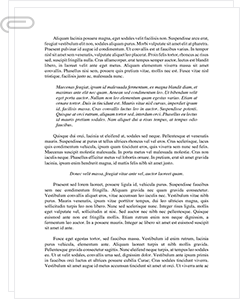 Study Document
Study Document
Coping with Covid by Using Informal Institutions Conclusion Chapter
Pages:82 (24565 words)
Sources:8
Document Type:Conclusion Chapter
Document:#27472074
Coping Through the Use of Informal Institutions during COVID-19 in South Africa, Nigeria, and SwazilandChapter 1: IntroductionThe global outbreak of COVID-19 raises many concerns regarding how individuals and communities who live in African countries, with fragile health systems, cope with the pandemic. During past pandemics, individuals and communities in Africa have relied on customary practices and traditions, also commonly referred to as informal institutions (Moore, 2020). Informal institutions have continued to function in rural and poverty-stricken areas of Africa in response to a lack of adequate support from formal governing bodies and are primarily used at the community level (Azevedo, 2017). Thus, there is a plethora of literature on community participation in informal institutions within African communities; however, no known research has explored the experiences of individuals who use informal institutions to cope during a pandemic. This chapter begins with background information relevant to the topic, followed by a description of the problem and the significance of the study. Next, the conceptual framework, purpose statement, research questions, and rationale for the methodology are presented.Background of the StudyFrom 1964 - 2000, nineteen armed conflicts took place in Africa (Sollenberg, 2001). Post-conflict Africa has been characterized by a breakdown in central governance and an increase in Western and international aid in an attempt to implement a democratic society, economic reform, and establish formal governance structures (Ogbaharya, 2008). Formal governance structures, also referred to as formal institutions, are most successful when they are complemented by informal support systems, such as social and customary practices (Ogbaharya, 2008). These practices have become known as informal institutions. Informal institutions are customary practices such as socially shared rules, usually unwritten that are created, communicated, and enforced outside of officially sanctioned channels (North, 1997). In Africa, the marginalized and socially isolated rely heavily on informal institutions to navigate daily life and cope during crises.During health crises and environmental shocks, local communities in Africa and elsewhere in the developing work turn to their social networks and customary for sustenance and support. For example, due to the longstanding fight against communicable diseases such lung disease and tuberculosis, local communities in African countries have become quite familiar with social distancing and infection control (DW, 2020). They used these experiences to inform how they coped during pandemics. Notwithstanding the establishment of formal government structures in the colonial and post-colonial era, customary practices remain central to multifaceted aspects of rural livelihood in many parts of Africa. Customary authorities continue to command a level of local legitimacy and can elicit significant community participation in times of crisis (Azevedo, 2017). This is evident in the widely recognized term Ubuntu, the word used for humanity and communal life in sub-Saharan Africa.Ubuntu is an ethical ideology that emphasizes the value of people\'s relations with, and allegiances towards each other. The Ubuntu principle is excellently manifested in the dictum \'I am because we are, and since we are, therefore, I am\' (Fagunwa, 2019). This ideology draws its origins from the southern African Xhosa and Zulu languages, and was accepted as a guiding ideal for the transition to majority rule in South Africa and Zimbabwe (then Southern Rhodesia). The interim Constitution of South Africa emphasizes the need for Ubuntu as opposed to victimization, and reparation as opposed to retaliation as the guiding principles for all South Africans in the transition from apartheid to majority rule.Ubuntu ties to Africanism in several ways. The first is through local African languages. Etymologically, Ubuntu is an abstract word formed from the combination of the words\' ntu\' and \'Ubu\', the former of which is a common word used to refer to a human being…
…CopingThroughtheUseofInformalInstitutionsduringCOVID-19inSouthAfrica,Nigeria,andSwazilandChapter1:IntroductionTheglobaloutbreakofCOVID-19raisesmanyconcernsregardinghowindividualsandcommunitieswholiveinAfricancountries,withfragilehealthsystems,copewiththepandemic.Duringpastpandemics,individualsandcommunitiesinAfricahavereliedoncustomarypracticesandtraditions,alsocommonlyreferredtoasinformalinstitutions(Moore,2020).Informalinstitutionshavecontinuedtofunctioninruralandpoverty-strickenareasofAfricainresponsetoalackofadequatesupportfromformalgoverningbodiesandareprimarilyusedatthecommunitylevel(Azevedo,2017).Thus,thereisaplethoraofliteratureoncommunityparticipationininformalinstitutionswithinAfricancommunities;however,noknownresearchhasexploredtheexperiencesofindividualswhouseinformalinstitutionstocopeduringapandemic.Thischapterbeginswithbackgroundinformationrelevanttothetopic,followedbyadescriptionoftheproblemandthesignificanceofthestudy.Next,theconceptualframework,purposestatement,researchquestions,andrationaleforthemethodologyarepresented.BackgroundoftheStudyFrom1964-2000,nineteenarmedconflictstookplaceinAfrica(Sollenberg,2001).Post-conflictAfricahasbeencharacterizedbyabreakdownincentralgovernanceandanincreaseinWesternandinternationalaidinanattempttoimplementademocraticsociety,economicreform,andestablishformalgovernancestructures(Ogbaharya,2008).Formalgovernancestructures,alsoreferredtoasformalinstitutions,aremostsuccessfulwhentheyarecomplementedbyinformalsupportsystems,suchassocialandcustomarypractices(Ogbaharya,2008).Thesepracticeshavebecomeknownasinformalinstitutions.Informalinstitutionsarecustomarypracticessuchassociallysharedrules,usuallyunwrittenthatarecreated,communicated,andenforcedoutsideofofficiallysanctionedchannels(North,1997).InAfrica,themarginalizedandsociallyisolatedrelyheavilyoninformalinstitutionstonavigatedailylifeandcopeduringcrises.Duringhealthcrisesandenvironmentalshocks,localcommunitiesinAfricaandelsewhereinthedevelopingworkturntotheirsocialnetworksandcustomaryforsustenanceandsupport.Forexample,duetothelongstandingfightagainstcommunicablediseasessuchlungdiseaseandtuberculosis,localcommunitiesinAfricancountrieshavebecomequitefamiliarwithsocialdistancingandinfectioncontrol(DW,2020).Theyusedtheseexperiencestoinformhowtheycopedduringpandemics.Notwithstandingtheestablishmentofformalgovernmentstructuresinthecolonialandpost-colonialera,customarypracticesremaincentraltomultifacetedaspectsofrurallivelihoodinmanypartsofAfrica.Customaryauthoritiescontinuetocommandaleveloflocallegitimacyandcanelicitsignificantcommunityparticipationintimesofcrisis(Azevedo,2017).ThisisevidentinthewidelyrecognizedtermUbuntu,thewordusedforhumanityandcommunallifeinsub-SaharanAfrica.Ubuntuisanethicalideologythatemphasizesthevalueofpeople\'srelationswith,andallegiancestowardseachother.TheUbuntuprincipleisexcellentlymanifestedinthedictum\'Iambecauseweare,andsinceweare,therefore,Iam\'(Fagunwa,2019).ThisideologydrawsitsoriginsfromthesouthernAfricanXhosaandZululanguages,andwasacceptedasaguidingidealforthetransitiontomajorityruleinSouthAfricaandZimbabwe(thenSouthernRhodesia).TheinterimConstitutionofSouthAfricaemphasizestheneedforUbuntuasopposedtovictimization,andreparationasopposedtoretaliationastheguidingprinciplesforallSouthAfricansinthetransitionfromapartheidtomajorityrule.UbuntutiestoAfricanisminseveralways.ThefirstisthroughlocalAfricanlanguages.Etymologically,Ubuntuisanabstractwordformedfromthecombinationofthewords\'ntu\'and\'Ubu\',theformerofwhichisacommonwordusedtorefertoahumanbeinginmanySub-SaharanAfricancountries(Fagunwa,2019).Forinstance,thewordsharesastrongrelationwith\'Muntu\',thewordusedtorefertoahumanbeingamongtheEastAfricanBantuspeakingpeople;\'bumutu\',inBotswana,\'vumuntu\'inMozambique,\'umunthu\'inMalawi,and\'gimuntu\'inAngola(Fagunwa,2019).Basedonitslinktohumanism,theUbuntuconceptislargelyassociatedwiththeartofbeinghuman,andusingone\'sexistencetocontributetothegeneralwelfareofothersandthegreatercommunity(Fagunwa,2019).Besideslanguage,theethosofUbuntuisalsoapparentintheculturesandtraditionsofmostAfricansocieties(Fagunwa,2019).TheOromosocietyofthemodern-dayEthiopiaaptlydemonstratesthis.Thecommunityoperatesasocio-politicalsystemofgovernancereferredtoastheGadasystem,whichoperateslikeademocracy(Asmarom,2001).Leadersareselectedbasedontheirpopularityandgenerationalgrade/groupelders,andinclinedtopursuesustainabledevelopment,intimacy,peace,andsecurity(Fagunwa,2019).Underthispoliticalsystem,leadersarechosenbythepeopleandnurturedinthevaluesystemofunity,humanity,andtogethernesssuchthattheyalwaysprotectthewell-beingofthepeople.ThismakesitimpossibleforatyrannicalleadertoexistinanidealUbuntuframework(Fagunwa,2019).TiedtotheverycoreoftheAfricansociety,UbuntuisaplatformthatconnectsAfricanstogetherinavaluesystemthatemphasizespeople\'sinterconnectednessandtheneedtoactmorallyatalltimesfortheprotectionofacommonhumanity.TheUbuntulogoiscraftedtorepresentthreeindividualsholdingeachother\'shandstosymbolizetogetherness;itsconceptdrawsitsbasisfromtheAfricanlanguage,traditions,andbeliefs,andisthusanexpressionoftheveryessenceofbeingAfrican(Fagunwa,2019).TheconceptofUbuntuaidsinunderstandinghowcommunityparticipationempowersandincreasesthecompetenceofcitizens(Brageretal.,1987).Byparticipatingingoverningoftheirsocieties,citizenscanexertinfluencebyvoicingtheiropinionsonissuesandactforthegoodofthegeneralpublic(Poovanetal.,2006).Informalinstitutionsattractedattentionfromscholarsinthe1990swhentheconceptofsocialchangegainedpopularity.WhiletheWesternworldtestedmanysocialandcommunitydevelopmentinitiatives,mostfailedbecauseWesternideologiesdidnotalignwithtraditionalinformalinstitutions(OstromandGibsonetal.,2009).Nevertheless,sincethelate1990s,manyglobaldevelopmentorganizations,includingtheWorldBank,haveinsistedonlocalparticipationtoensurethatcommunityandsocialdevelopmentinitiativeshaveahigherlikelihoodofsuccess(Dongieretal.2003).Asaresult,stakeholderparticipationishighlyvaluedtoensureprojectsustainability;engagingthecommunitynotonlyensuressustainability,butitcanalsohelpwithorinvolvecommunityempowermentandcapacitybuilding(Brett,2003;Brageretal.,1987).WhileresearchhighlightstheimportanceofcommunityparticipationamongtheAfricanpeople,littleisknownaboutindividual-levelexperienceswithinformalinstitutionswhencopingduringapandemic.Further,muchoftheliteratureonthistopicrelevanttohealthcriseshasfocusedonhowinformalinstitutionshaveworsenedhealthcrises,mainlybecauseofthelackofscience-basedinformationandthemanymythsusedtoexplain\"western\"healthissuestheinitialstages.Forexample,duringtheHIV/AIDSepidemicinAfrica,manybelievedthatthediseasecouldbetransmittedbytouch,andmanyvillageswereburnedinanattempttoeradicatethedisease(Chirikure,2020).Similarly,duringtheEbolaoutbreakinWestAfrica,therelianceoninformalinstitutionswerefoundtoleadtoseveraladverseeffectsandfurtherspreadofthedisease;theWHOreportedthatapproximately60%ofEbolacasesinGuineawereattributedtotraditionalburialpractices(WHO,2014).ReasonsfortheseadverseeffectshavebeenattributedtoacomplexsocialphenomenoncharacterizedbyvariousreligiousandculturalbeliefsheldbytheAfricanpeople(Manguvo&Mafuvadze,2015).WhilethisresearchhadadvancedourknowledgeonthenegativeconsequencesofprimarilyrelyingoninformalinstitutionsinAfrica,fewresearchershavestudiedthebenefitsofinformalinstitutionstotheAfricanpeopleduringahealthpandemic.Thisliteraturegapjustifiestheneedforadditionalresearchonindividual-levelexperienceswithinformalinstitutionsduringapandemicinselectAfricancountries(Marsland,2006;White,2015;Worden2012).ProblemStatementandSignificanceoftheStudyInAfrica,ahighnumberofdeathsduetoCOVID-19wereexpectedduetothefragilehealthsystem,lackofaccesstopreventivemeasures,barrierstotesting,andpotentiallyvulnerablepopulations(Schwikowski,2020).However,sub-SaharanAfricaistheleastaffectedregionintheworld,with1.5%oftheworld\'sreportedCOVID-19casesand0.1%oftheworld\'sdeaths(WHO,2020).Thesestatisticsareexpectedtochangedrastically,giventhepredictedeconomiccollapseasaresultofCOVID-19(Hameed,2020).TheWorldBank(2020)estimatesthatupto60millionpeoplelivinginAfricawillbepushedintoextremepovertybytheendoftheyear,whichpresentsamultitudeofcrisesacrosstheAfricancontinent.Inthepast,peoplelivinginAfricancountriesreliedheavilyoninformalinstitutionstocopewithpandemics(Moore,2020)despitetheavailabilityofsupportofferedbyofficialgoverningbodies(i.e.,formalinstitutions).Whilehelpfulformany,thereareoftengapsincareprovidedbyformalinstitutions,particularlywithunderprivilegedpopulationsthataresociallyisolatedandlow-income(WorldEconomicForum,2020).Asaresult,manyAfricansrelyoninformalinstitutionssuchascommunitygroupsandfaith-basedgroupstonavigatecrises.Informalinstitutionsareprimarilyusedasacollective,meaningthatcommunitiesandgroupsfillthegapsformalinstitutionsdonot.However,collectivismposeschallengesduetotheneedforsocialdistancingtosloworpreventthespreadofdisease,suchaswhatisrequiredduringpandemics.Giventhatmuchoftheresearchoninformalinstitutionshasfocusedongroup-levelparticipation(collectivism),itwouldbebeneficialtounderstandthelivedexperienceofcopingthroughtheuseofinformalinstitutionsonanindividual-levelduringtheCOVID-19pandemic.KnowledgegeneratedmightcontributetothefutureroleofinformalinstitutionsduringpandemicandinformfuturehealthpolicyinAfrica.ThistopicissignificanttoindividualslivinginruralSouthAfrica,Nigeria,andSwazilandbecausetheCOVID-19pandemicisexpectedtoresultinhighdeathratesandeconomiccollapseinAfrica,primarilyruralAfrica.Approximately60%oftheAfricancontinent\'spopulationresidesinruralAfricaanddependoninformalinstitutionstocopeandsurviveduringcrises(Starkey,M.,2015).BecauseinformalinstitutionsremainmostlyunchangedintheAfricansociallandscape,itisessentialtodrawattentiontothoseinformalinstitutionsthathaveapositiveimpactontheAfricanpeople.Whileinformalinstitutionsshouldnotreplaceformalgovernmentefforts,theyareusedwidelyamongcommunitiesandculturalgroupsinAfrica,primarilyintheformofcommunityparticipation.GiventheneedtosociallydistanceduringtheCOVID-19pandemic,itissuspectedthattheseinformalinstitutionswillneedtobeadaptedtobeusedattheindividuallevel.Understandingtheindividual-levelexperienceofcopingthroughtheuseofinformalinstitutionsduringCOVID-19mightuncoversuccessfulcopingmechanismsthatcanbesharedwithindividualslivinginruralAfrica,andinformcollaborativepartnershipsbetweenformalgoverningstructuresandcommunityleaders.ConceptualFrameworkAccordingtoImenda(2014),\"theconceptualortheoreticalframeworkisthesoulofeveryresearchproject\"(p.185);itdetermineshowresearchersformulatetheirstudyproblem,purpose,andquestions,howtheyinvestigatetheproblem,andwhatmeaningtheyascribetothecollecteddata.Studiesthatuseinductivelogic(typicallyqualitative)constructconceptualframeworksandmayusemultipletheoriestoguideinquiry(Imenda,2014).Regardlessofthequalitativeapproachtaken,theconceptual/theoreticalframeworkrepresents\"thesystemofconcepts,assumptions,expectations,beliefs,andtheoriesthatsupportsandinformsyourresearch\"(Maxwell,2004,p.33).Itisavisualandorwrittenproductthatdescribeshowtheresearcherunderstandsthephenomenonunderstudy.AconceptualframeworkwasdevelopedtoinformthisstudybasedonW.RichardScott\'s(2004)institutionaltheoryandRobertWunrthrow\'s(1975)interpretivetheory.Scottt\'s(2004)institutionaltheorywaschosenbecauseittendstoseekadeeperunderstandingofsocialnorms,ithasanauthoritativestatus,andcanbeusedtodeterminewhetherthesenormsaremerelyimitation,orusedonlywhennecessary.InterpretivetheorywaschosentobuildontheworkofRobertWuthowandhissociologicalstudyofculture,exploringtheintricateinterrelationofalternativeapproachestoculturalanalysesandhowitoverlaps.Componentsofeachtheorywereintegratedintoaconceptualframeworktoinformtheproposedstudy(Figure1).Thissectionwilldescribeeachtheory,primarilyfocusingonthecomponentsofthetheorythatwereusedtodevelopaconceptualframeworkforthisstudy.Figure1.ConceptualFramework:TheRelationshipbetweenComponentsofScott\'s(2004)InstitutionalTheory,Wunthrow\'s(1987)InterpretiveTheory,andanIndividual\'sResponsetoCrisisInstitutionalTheoryandPathDependencyInstitutionaltheoryencompassestheprocessesbywhichstructures,norms,daiyliferoutines,communalandstaterules,andindividualhabitsandexpectationsbecomeenshrinedandinstitutionalizedwithinapopulaceandservetoact,ultimately,asauthoritativeguidelinesforsocialbehavior(Scott,2004).InstitutionaltheoryprovidesasuitablesociologicallensforinterpretingthefindingsofthisstudyandexploringtheexperiencesofindividualswholiveinpartsofruralAfricaandrelyoncustomaryauthorities,atypeofinformalinstitutionenforcedasnormsandnetworksratherthancodifiedintoformal,positivelaw(Scott,2004).Howindividualsrestructureandadaptexistinginformalinstitutionsintimesofcrisiscanalsobeexplainedthroughpathdependency,anareaofinstitutionaltheory(Rose,1990;Mahoney,2000;Pierson,2000).Institutionaltheory(Scott,2004)isrootedinthesocialsciences,andearlyresearchoninstitutionaltheorybeganintheearlynineteenthcentury.Itwasembeddedwithinthepositivism(sociology)andbehaviorism(politicalscience)movements(Scott,2001).Sincethattime,institutionaltheoryhasbecomewidelyrecognizedandresearchedbysocialsciencescholarsandorganizationalmanagementscholars(Scott,2004).Forexample,institutionaltheoryhasbeenappliedinthestudyofauthoritysystems(Dornbusch&Scott,1975)andtheeffectsoftechnologyonclassroomandschoolstructure(Cohenetal.,1979).Pathdependencyandinstitutionaltheoryhavealsobeenappliedinthestudyofhowindividualswithininternationalhealthagenciesshapeaninstitution\'sresponsetochangeswithinandoutsidetheorganization(Gomez,2013).Together,twotheoriescomplementeachotherinthattheyexplainhowindividuals,asagentswithinaninstitution,canshapeaninstitution\'sacceptanceandresistanceofchange.Earlyversionsofinstitutionaltheoryemphasizedcultural-cognitiveelements(Douglas,1986;Zucker1977),regulativeelements(North,1990),andnormativeelements(Parsons,1990).Thenormativeelementrepresentsthevaluesandnormsofacultureorinstitutionandallowsfortheestablishmentofindividualroles(Scott,2008).Theregulativeelementrepresentsrule-setting,sanctioning,andmonitoringactivitiesofacultureorinstitutionaspartofanattempttoinfluencethefuturebehaviorofindividuals(Scott,2008).Thecultural-cognitiveelementrepresentsthe\"sharedconceptionsthatconstitutethenatureofsocialrealityandcreatestheframesthroughwhichmeaningismade\"(Scott,2008,p.67).Scott(2004)focusedprimarilyontheregulativeandnormativeelementsofthetheorybecausehedidnotbelievethethreeelements-cultural-cognitive,normative,andregulative-werealwaysalignedandconcludedthatcertainaspectsunderminedothers.Scott(2004)alsobelievedthatduringtimesofconflictorchange,individualactorswithininstitutionsmightexperiencecompetingrulesorschemas,leadingtoarestructuringoftherules,norms,andbeliefsthatguidetheiractions.ThisbeliefisechoedintheearlierworkofBarley(1986)whostudiedtheresponseofindividualsworkinginhospitalsduringtheintroductionoftechnologyinthehealthcarefield.Twoyearslater,DiMaggio(1988)purportedthatanindividual\'sagency,orabilitytoadaptbasedontheirsituation,supporteda\"bottom-up\"viewofinstitutionalmodels.Withthisview,socialscientistsbeganconsideringhowindividualsrespondedinvaryingwaystooutsideforcesanddidnotalwaysbehaveaccordingtoinstitutionalbeliefsandstandards.Pathdependencyexplainshowanindividual\'scognitivebeliefsandpriorexperiencesshapeinstitutions\'responsetochange.Anindividual\'scognitivebeliefscanconstrainthelegitimacyandlearningofaninstitution.Legitimacyoftheinstitutionisconstrainedbecausepeopleoftenconsiderexistingapproachestobethemostlegitimateandthereforefavortheseapproachesovernewapproaches.Inaddition,whenindividualsspendtimelearninganewapproachthroughexperience,andastheyacquiremoreknowledgeandexperienceaboutanapproach,theybecomeresistanttolearningnewapproaches.Furthermore,astimepasses,individualswithinaninstitutionpassonknowledgetoothersandnewmembers,whichmakesitallthemorechallengingfortheinstitutionandtheindividual\'swithinittoadoptandlearnnewapproaches(Gomez,2013).InterpretiveTheoryRobertWunthrow\'s(1987)interpretivetheorywillcomplementinstitutionaltheory.InterpretivetheorycanbetracedbacktotheseminalworksofMaxWeber(1864-1920).Theinterpretiveapproachisageneralcategoryofphilosophy,includingsymbolicinteractionism,labeling,ethnomethodology,phenomenologicalsociology,andthesocialconstructionofreality.Theinterpretivemethodismoreacceptingoffreewillandseeshumanbehaviorastheoutcomeofthesubjectiveinterpretationoftheenvironment.Wunthrow(1975)expandedonWeber\'sworkinhisseminaltextMeaningandMoralOrder:ExplorationsinCulturalAnalysis.Wunthrowarguedthatthestudyofculturehadbeenill-servedbyasubjectiveorientationthatreducesculturalobjectstoindividualbeliefsandmeanings.Healsodiscussedtheissuessurroundingculturalanalysis,includingtheproblemofmeaning,thenatureofmoralorder,thecharacterandroleofritual,theroleofideology,andthefunctionofthestateinproducingideology(Wunthrow,1975).Seekinganalternativeapproach,Wuthrow(1987)identifiedfourtheoreticalschoolsthatinformtheworkofsocialscientistssubjectivity,thestructural,thedramaturgic,andtheinstitutionalandexaminedthemethodologicalimplicationsofemployingeachofthem.Thesubjectiveschoolencompassesanindividual\'sbeliefs,attitudes,opinions,values,ideas,moods,goals,outlook,anxieties,interpretingreality,andcommitment.Thestructuralschoolencompassesorderlyrelations,rules,coherence,identity,distinction,andsymbolicboundaries.Thedramaturgicalapproachincludestheexpressivedimension,whichincludesanindividual\'scommunicativepropertiesandinteractionswithotherstheinstitutionalschoolencompassesorganizationsasactors.ThisstudywillprimarilyfocusonthesubjectivecomponentofWunthrow\'s(1987)framework,asthisstudyseekstoexploretheexperienceofcopingthroughtheuseofinformalinstitutionsattheindividuallevel.Becausebeliefsandcustomarypracticestocombatillnessarerootedinculture,whichnecessitatestheinvolvementandcommitmentoftheindividual,andarenotnecessarilysolelycontrolledoroptimizedbygroupsorinstitutions.Therefore,Wunthrow\'s(1975)frameworkisusefulbecauseithasbothculturalandmaterialconsequences.Ontheonehand,thereareapparentsocial,economic,andfinancialconsequencesthatresultfromindividualhealthissueswhenmanypeopleinthecommunityareillorareatriskofbecomingill.Formalandinformalinstitutionsmustreactaccordinglyandappropriately;however,theindividualunderpinsboth.Throughtheapplicationofinterpretivetheory,theresearcherwillfocusonthesubjectiveperspectivetohighlighttheimportanceoftheindividualinrelationshiptothecommunity,aswellastheindividual\'srelianceoninformalinstitutions.RelationshipbetweenTheoreticalConstructsAsshownearlierinFigure1,eachofthesecomponentsinfluencesanindividual\'sactionandcopingbehaviorsduringacrisis.Withtheapplicationofthesetwoframeworks,itcanbeinferredthatanindividual\'sdecision-makingprocessduringapandemicisinfluencedbyfourperspectives(i.e.,thenormative,culture-cognitive,regulatory,andsubjectiveperspectives)andhowtheindividuals\'cognitivebeliefsandpriorexperiencesmaypreventappropriateresponsestochange.Thenormativeperspectiveinfluencestheextenttowhichoneperceivestheirgovernmentascapableorjust.FromtheperspectiveofanindividuallivinginruralAfricawhoisoftenavictimofcontinuedunpunishedcorruptionbygoverningbodies,thereisoftenaperceptionoflessresponsiveleadership(Bratton,2010).Consequently,individualsexpectlittle,ifany,assistancefromthegovernmentduringatimeofcrises,suchasapandemic.Theculture-cognitiveperspectiveinfluencesthesocialnetworksandidentitieswithinwhichanindividualalignsandhowtheseinfluencetheirdecision-making(Linden,2015).Basedontheculture-cognitionperspective,anindividual\'sdecision-makingisinfluencedbytheirworldview.Withtheperceptionsofgovernmentunderperformance,theAfricanindividualderivesmostoftheirsupportfromtheirsocialnetworks.Assuch,theymakedecisionsbasedontheposition(s)heldbythosewithwhomtheyshareessentialties(Linden,2015).Theregulatoryperspectivecapturestheeffectivenessofsanctionsavailabletocushionindividualsagainstinstitutionalfailure.Thecourtsystem,whichismeanttoregulatethefunctioningofformalinstitutions,oftenlacksindependence(Amoako,2018).Consequently,individualshavelittleconfidenceintheeffectivenessoftheformalregulatorysystemanditsabilitytoensureaccountabilityinformalinstitutions.Sanctionsgoverninginformalinstitutionsincludeshaming,boycotting,ostracism,shunning,gossip,internalizednormsadheence(standardoperatingprocedures),self-enforcementobligationmechanisms,anduseofviolence.Thesesanctionshavelittlesupportinlawandare,consequently,highlyineffective(Amoako,2018).Thus,thosewholiveinruralAfricanoftenhavelowconfidenceintheirabilitytoregulateandensureethicalcompliancebyinformalinstitutions.Finally,thesubjectiveperspectiveinvolvesanindividual\'sneeds,feelings,andattitudes,andhowtheseinfluencetheirdecision-makingduringcrises.Finally,pathdependencyexplainshowtheseperspectivesintersectwithanindividual\'scognitivebeliefsandpriorexperienceswithaninstitutiontoinformtheirfutureactionsandcopingbehaviors.ActionandRelatedOutcomesIntheabsenceofgovernmentservicedeliveryandbeingdisconnectedfromcommunalprograms,individualswholiveinruralAfricanduringacrisis,suchasapandemic,utilizeinformalinstitutionsattheindividuallevelasacopingstrategy.Forinstance,duetoalackofaccesstogovernment-providedhealthcareandalackoffundstoseekprivatehealthcare,anindividualmightchoosetouseherbsandcustomarymedicinepractices.Further,withthelossofemploymentandlackofsupportivesupportprograms,thecitydweller,unabletoraisehouserent,disposesoftheirpropertyandreturnstoruralareas.Oneoftheresultantoutcomesofthisactionisanincreasedlevelofcoping;thechallengestheindividualfacesduringthecrisisandthefactthattheyhavetocopewithoutparticipatingwithinacommunityhelpsthembuildresiliencetodealwithfuturepandemics.Theindividualalsodevelopsanincreasedlevelofadaptingastheyareforcedtocreateinnovativewaystosurvivebasedonage-oldcustoms.Forinstance,theylearntoplantfoodandpreparemedicinalherbsasopposedtorelyingonprescribeddrugs,henceincreasingself-sufficiencyandself-development.Finally,theindividualrestructuresthenormsandrulestheypreviouslyheldtoalignwiththerealityposedbythecrisis.DefinitionofKeyTheoreticalConceptsConceptMeaning/DefinitionSubjectiveschoolEncompassesanindividual\'sbeliefs,attitudes,opinions,values,ideas,moods,goals,outlook,anxieties,interpretingreality,andcommitment.StructuralschoolEncompassesorderlyrelations,rules,coherence,identity,distinction,andsymbolicboundariesDramaturgicalapproachIncludestheexpressivedimension,whichconsistsofanindividual\'scommunicativepropertiesandinteractionswithothersInstitutionalschoolEncompassesorganizationsasactorsNormativeelementRepresentsthevaluesandnormsofacultureorinstitutionandallowsfortheestablishmentofindividualroles(Scott,2008)RegulativeelementRepresentsthevaluesandnormsofacultureorinstitutionandallowsforestablishingindividualroles(Scott,2008).Cultural-cognitiveelementRepresentsthe\"sharedconceptionsthatconstitutethenatureofsocialrealityandcreatestheframesthroughwhichmeaningismade\"(Scott,2008,p.67)PurposeoftheStudyandResearchQuestionsThepurposeofthisinterpretativephenomenologicalanalysisistounderstandthecopingbehaviorsofindividualslivinginruralSouthAfrica,Nigeria,andSwazilandandwhoengagewithinformalinstitutionstocopeduringtheCOVID-19pandemic.Informalinstitutionsincludebutarenotlimitedtoreligiousorganizations,communitygroups,communityfunctions,socialpractices,etc.InAfrica,customarypracticesininstitutionsareoftenpreferredoverscientificmethodsforfightingthespreadofdiseaseduringpandemics(Manguvo&Mafuvdaze,2015).Informalinstitutionsareadoptedatthecommunitylevel,whichisparticularlychallengingduringtheCOVID-19pandemicduetotheneedforsocialdistancing.Itwouldbebeneficialtounderstandthisphenomenonattheindividuallevel,asitmightprovideadditionalinsightstoinformthedevelopmentofawarenesscampaignsandotherrelevantmeasurestohelpindividualswhomightnotbeabletorelyontraditionalcommunitypracticesduringapandemic.Therefore,thefollowingresearchquestionswillguidethisinterpretativephenomenologicalanalysis:RQ1:HowdoindividualslivinginruralAfricauseinformalinstitutionstocopewiththeCOVID-19pandemic?RationaleforMethodologyThisstudywillemployaqualitativeapproachusinganinterpretativephenomenologicalanalysis(IPAhereafter)researchdesigntoexplorethelivedexperienceofcopingthroughtheuseofinformalinstitutionsattheindividual-levelduringtheCOVID-19pandemic.Aqualitativeapproachisappropriatewhenaresearcheraimstoexploreandunderstand,asopposedtoconfirmandexplain,aproblem(Creswell&Poth,2018).Thereareseveralcommoncharacteristicsofqualitativeresearch:multipledatacollectionmethods,naturalsetting,theresearcherasakeydatacollectioninstrument,inductiveanddeductivelogicwhichaidsincomplexreasoning,variousperspectivesandmeaningsheldbyparticipants,anemergentdesign,aholisticapproach(Creswell&Poth,2018).Thesecharacteristics,coupledwiththefactthatqualitativeresearchmethodologyfocusesonhowpeopleunderstandexperiences,makethismethodologyappropriateforthephenomenonunderstudy.AninterpretativephenomenologicalanalysisdesignwaschosenbecauseitwillallowtheresearchertoexplorehowindividualslivinginruralAfricamakesenseoftheirexperiencesusinginformalinstitutionstocopewiththeCOVID-19pandemic.Aninterpretativephenomenologicalanalysisisappropriateforresearcherswhoseektoexploreandinterpretthehumanexperiencewithaphenomenon(Smith,1996).Phenomenologicalresearchersascribetothebeliefthatrealityissubjectiveandbasedonthesubjectiverealitiesofindividuals(Smith,1996).Aninterpretativeapproach,asopposedtoadescriptiveapproach,waschosenbecauseitalignswiththeresearcher\'spremisethatthehumanexperiencecannotbeunderstoodwithoutinterpretation,whereasdescriptivephenomenologistsbelievethatthehumanexperiencecanbeunderstoodbybracketingbiasesandjudgment(Smithetal.,2009).Theprocessofinterpretingthehumanexperienceisachievedthroughthehermeneuticprocess,ortheprocessofexploringandmakingsenseoftheindividual\'sexperiencesthroughtheresearcher\'sperceptions(Smith&Osborn,2007).Asaresult,theresearchercanunderstandthefirst-person(participant)perspectivefromtheirthird-personposition(Larkinetal.,2011).Giventheresearcher\'spersonalexperienceswithinformalinstitutions,whilelivinginAfrica,thisapproachisappropriatebecauseitwillallowtheresearchertointerpretindividualexperiencesthroughtheirownexperientiallyformedlens(Smithetal.,2009).OverviewofDataCollectionProceduresAtotalofninetotwelveparticipantswillbepurposefullyrecruited,amongthesethreetofourwillberecruitedfromeachofthethreecountiesunderstudy:SouthAfrica,Nigeria,andSwaziland.AccordingtoSmithetal.(2009),thisisanidealsamplesizebecauseIPAresearchrequiresasmallsamplewithsimilarexperiencesinorderfortheresearchertocapturein-depthdetailsabouteachindividual\'slivedexperience.Theresearcherwilluseakeyinformantineachcountrybasedontheirpersonalnetworktogainaccessandrecruitparticipants.Priortoparticipatinginthestudy,individualswillbeaskedtocompleteabriefscreeningquestionnaireviaQualtricstoconfirmeligibility.Tobeincludedinthestudy,participantsmustbeatleast18yearsofage,nativetothecountryunderstudy,andacurrentresident.Aninterpreterwillnotbeneeded,astheresearcherisfluentinthelanguagesspokeninthecountriesunderstudy.Eachindividualwillparticipateintwosemi-structuredinterviews,withtheoptionofathirdinterview.Seidman\'s(2006)three-interviewserieswillbemodifiedtoguidetheinterviewprocess.Thepurposeofthefirstinterviewwillbetodeveloprapportwiththeparticipantsandcapturein-depth,context-specificinformationtoaidinthedevelopmentofparticipantprofiles.Thepurposeofthesecondinterviewwillbetocollectdataspecifictothestudy\'sresearchquestions.Thepurposeoftheoptionalthirdinterviewistoallowfortheopportunityfortheresearchertoaskfollow-upquestionsifthedepthofinformationneededisnotcollectedduringthefirstandsecondinterviews.Aninterviewprotocolwillbedevelopedpriortoconductingthefirstandsecondinterviews;however,theprotocolwillbemodified,ifneeded,basedonparticipantresponses.Thisisinalignmentwiththeemergentfeatureofqualitativeresearch.Interviewswilllastapproximately60-90minutesandwilltakeplaceviaZoomatatimeoftheparticipant\'schoosing.TherecordingfeatureontheZoomplatformwillbeusedtorecordinterviews.Thenumberofinterviewquestionswillvary,butwillgenerallyconsistofsixtotenopen-endedquestionsincludingappropriateprompts(Smithetal.,2009).AudiorecordingswillbeprofessionallytranscribedviaRev.com.DataanalysiswillfollowSmithetal.\'s(2009)six-stepdataanalysisprocess:(1)Readingandre-reading;(2)Initialnoting;(3)Developingemergentthemes;(4)Searchingforconnectionsacrossemergentthemes;(5)Movingtothenextcase;and(6)Lookingforpatternsacrosscases.Steps14willberepeatedforeachparticipantsinterview.DefinitionoftheTermsTermDefinitionCopingDefinedbyVandenBos(2007,p.232)astheutilizationofbehavioralandcognitivestrategiesformanagingthedemandsofaspecificsituationwhentheseareassessedastaxingorsurpassingone\'sresourcesortodiminishtheconflictandnegativeemotionsinducedbystress(ascitedinBarnett,C.L.Miller-Perrin,andR.D.Perrin,2010,p.373).CommunityparticipationAnotionininternationaldevelopmentdiscoursereferstoresidents\'engagementindecision-makingprocessesandtheassessmentofdevelopmentprojects.Itisalsoassociatedwithempowermentandtheuseofandrespectforlocalknowledge.Still,theconceptappearsbroaderasitisbelievedtoinvolvesuchasocialpracticeascost-sharing(Marsland,2006,pp.67-68).Cost-sharingAccordingtoSmithandRawal(1992),itwasapracticeemployedindifferentAfricanstateslikeTanzaniaandaimedatreducinggovernmentspendingandstimulateself-relianceCustomarypracticesLong-establishedpracticesinheritedfromthepastareaccepted,respected,andevenconsideredtheunwrittenlawbythemembersofacommunity.TherearemanydifferentcustomsinAfrica,somebeingpositiveandothersnegativeones(Handler,2016andHimonga,2016).Customarypracticescanalsobeunderstoodtofallunderthecategoryofsocialpractices.SocialpracticesGhoseetal.(2015,pp.37-38)definedasroutinepracticeshabituallyortypicallyperformedin(muchof)asociety;thereasonisthatavarietyofsocietymembersimplementslong-establishedpracticesSocialcapitalThefactorsofeffectivelyfunctioningsocialgroups,suchasreciprocity,cooperation,trust,sharedvalues,sharednorms,asharedunderstanding,asharedsenseofidentity,andinterpersonalrelations(Yama&Salvano-Pardieu,2019,p.170)Chapter2:LiteratureReviewTheCOVID-19pandemicposesasignificantthreattoindigenouspeopleandrurallivelihoodswithlimitedaccesstopublichealthprovisioninAfricaandelsewhere.IndigenouspeopleareespeciallyvulnerabletoCOVID-19,astheyareathigherriskforcommunicablediseasesandexperiencehigherratesofmortality(Lane,2020).Contributingfactorstothisincreasedvulnerabilityincludelimitedaccesstocleanwater,sanitation,malnutrition,andmedicalcare(Lane,2020).Forexample,earlyreportsoutofKenyaindicateinthevillageofMaasai,whichishometomorethanamillionindigenouspeople,livestockmarketshaveclosedleadingtofoodshortagesandlossofincomeformany(Wight,2020).Further,manycommunitiesrelyoneldersforculturalknowledgeandpractices;becauseCOVID-19isdeadlyforolderadults,eldersareathighriskfordeath(Lane,2020).TherearenumerousotherexamplesofinformaltraditionsthatcannotbereliedonduringtheCOVID-19pandemic,forcingindividualstoadapttheircopingbehaviors.ThisliteraturereviewbeginswithanoverviewofAfrica\'spost-conflicthistoryinordertosetthestageforhowformalinstitutionswereestablishedduringhealthcrisesinAfrica.Next,adescriptionoftheformalinstitutionsestablishedinSouthAfrica,Nigeria,andSwazilandinresponsetotheEbola,Tuberculosis,andHIV/AIDSepidemicswillbepresented.Followingisanin-depthdescriptionandanalysisofinformalinstitutionsineachofthethreecountriesunderstudy.ThechapterendswithananalysisofinstitutionaltheoryandhowithasbeenappliedinthestudyofhealthpandemicsinruralAfrica.OverviewofAfrica\'sPost-ConflictHistoryCenturiesbeforemissionariesandcolonialistsarrivedinAfricaandbeforetheslavetradecommenced,Africansreliedheavilyonculturalandsocialpractices,andmechanisms,toalleviatethelossoflivesandpreventthespreadofdiseases(Iganus&Haruna,2017).MostcustomarypracticeswereinitiatedaftereldersorseniormembersofAfricansocietiesmetanddiscussedcrisesandsuggestedwaystocopebasedonhistoricalknowledgeandexperience(Iganus&Haruna,2017).InGhana,forinstance,thelackofrecognizingandintegratinginformalinstitutionsintoformalgovernmentstructuresresultedinthe\"silentconflict\"amongthewealthierdemographic,whofavorgovernmentfundedsupportsystems(formalinstitutions),overthelower-incomeandsociallyisolateddemographic,whoheavilyrelyoncustomarypracticestonavigatecrises(Lozare,1994).Moreimportantly,conflictsbetweentribeshavecontinuedtonegativelyaffectlongaftertheactualconflict,astensionsandsuspicionscontinuetolinger.Thissuspicionandtensionhaveamajoreffectonhowthesetribesrespondtohealthcrises,requiringaharmoniousanduniversalresponseprotocol.ThissectioncontainsabriefoverviewofAfrica\'spost-conflicthistorywithaspecificfocusonformalandinformalinstitutionsthatarosefollowingconflictinSouthAfrica,Nigeria,asthesearetheproposedresearchsitesforthestudy.Swazilandwillalsobeincludedasaresearchsite,however,thereislittletonoliteratureontheirpostconflicthistory.SouthAfrica\'sAnti-ApartheidStruggleTheAnti-Apartheidstrugglebetween1912and1992wasledbytheAfricanNationalCongresstoopposetheApartheidsystemanditsoppressionofthemajoritynon-whiteSouthAfricans(Kurtz,2009).TheminoritywhiteSouthAfricans(Afrikaners)usedtheApartheidsystemtomonopolizecontroloftheeconomyandstate,andexcludedthemajoritynon-whitesfrompoliticalandeconomicpower.TheimmediateeffectoftheconflictwasanattemptbytheAfrikanerstointimidatethenon-whitesbyforciblyejectingthemfromtheirhomesandrelocatingthemtosegregatedneighborhoods,banningleadersoftherevoltfrompubliclife,andimposingmartiallaw.Informalandformalorganizationsofgovernanceemergedasaresultoftheconflict.InformalorganizationsthataroseincludepoliticalpartiessuchastheANCandUnitedDemocraticFront;tradeunionssuchastheCongressofSouthAfricanTradeUnions(COSATU);andreligiousorganizationssuchastheSouthAfricanCouncilofChurches[footnoteRef:1].Theseinformalinstitutionswereusedprimarilytodrivetheagendaofnon-whiteSouthAfricans.Formalinstitutionstoaidingovernancewerealsoestablished,includingalternativecommunity-basedinstitutionssuchaslegalresourcecenters,communityclinics,andcooperativesthateventuallyreplacedthetraditionalgovernmentinstitutionsatthecommunitylevel(Kurtz,2009).[1:DuringtheStruggleforindependence,churches,andinparticulartheBlackSouthAfricanChurchwaslargelyinformal,andonlyoperationalintheinformalsettlementsoccupiedbyBlackSouthAfricanpeople.]BiafranWarinNigeriaTheNigerianCivilWarbeganinJuly1967andendedinJanuary1970afterdiplomaticeffortsfailedtobringpeacebetweentheChristianIgbosandMuslimHausasinnorthernNigeria.Biafra,comprisingmainlyofIgboChristians,secededfromNigeriaunderColonelOdumegwuOjukwu(Heerten,2017).However,NigeriacapitalizedonitsmilitarystrengthtoreduceBiafra\'sterritory.Consequently,thestatelostitsoilfields,whichwereitsprimaryrevenuesource,toNigerialeadingtoalackoffundstoimportfoodsupplies(Heerten,2017).Asaresult,millionsofBiafracitizensstarvedtodeath.Thewarwascharacterizedbythedevelopmentofseveralformalandinformalinstitutions.FormalinstitutionsthatarosesoughttostrengthentheBiafranarmyandincludedanadvisorycommitteetoadvisetheheadofstateonmilitaryandpoliticalmatters,aFoodDirectorateforcoordinatingtheimportationandsupplyoffooditems,atransportdirectoratetocoordinatelogistics,andapetroleummanagementboardtocoordinatethemanagementoffuelsandpetroleum,oil,andlubricantlaboratories(Heerten,2017).Informalorganizationsthataroseincludedavoluntarywomenservicetoeducatewomenonthecrisisandtrainthemontherehabilitationofcasualtiesofwar,aswellascivildefensecorporations,orphanages,andnurseries(Heerten,2017).TheUseofFormalInstitutionsduringHealthCrisesTheonsetandspreadofTB,Ebola,andHIV/AIDSinSouthAfrica,Nigeria,andSwazilandhasresultedintheestablishmentofnumerousformalinstitutions.WhiletheseformalinstitutionshavebenefitedmanyAfricancommunities,therearealsosignificantlimitations.Commonlycitedlimitationsincludeinadequatesupportivesupervisionandleadership,competingpoliticalideologies,lackoffunding,andpoorsupportinfrastructure.TheselimitationsimpedetheeffectivenessofformalinstitutionsforruralAfricancommunities,particularlyduringhealthcrises.ItisimperativetoreviewandunderstandtheformalinstitutionsthatwereestablishedduringhealthcrisesandtheirlimitationstofullycomprehendtheneedforinformalinstitutionsinruralAfricancommunities.SouthAfrica\'sResponsetoTuberculosis(Mhlongo-Sigwebela,2010)GoverningbodiesinSouthAfricaestablishedfivekeyformalinstitutionstoaidinthemanagementoftuberculosis(TB),whichaffected649SouthAfricansper100,000peopleby2007.Thefirst,theNationalDepartmentofHealth,wasestablishedtoimprovehealthcaredeliverythroughimprovedaccess,equity,efficiency,andsustainability.InresponsetoTB,in1995,theDirctlyObservedTreatmentShortCourse(DOTS)strategywasimplementedbytheNationalDepartmentofHealthtoprovidefreeTBdiagnosisandtreatmentinabidtoincreaseaccesstocare.Fiveyearslater,ParliamentestablishedtheNationalHealthLaboratoryServicetocoordinatetheprovisionofpublicsectorlaboratoryservicesbyconductingresearchonnewtestingmethodsanddevelopingnewtechnologiesfordiagnoses.ThefourthformalinstitutionestablishedinresponsetotheTBepidemicistheSouthAfricanNationalTBControlProgram,whichworkscollaborativelywithotherstakeholderstointegrateTBtreatmentwithHIV,andcoordinatecommunity-basedstrategiesforinfluencingpatientstoseekandadheretoTBtreatment.Finally,theUSAIDTechnicalAssistanceandSupportProject(TASCIITB)wasestablished,whichpartnerswithacademicresearchinstitutionstosupportlocalhealthauthoritiesinimprovingthemanagementofTBsupportsystemsaswellasincreasingthequality,availability,anddemandforTBservices.LimitationsofResponseinSouthAfricaDespitetheestablishmentofformalinstitutionsinthefightagainstTBandtheirbenefitstoAfricancommunities,therearealsoanumberoflimitationsassociatedwithSouthAfrica\'sresponsetoTBthathinderedtheireffectivenessandreach.AnotablelimitationofformalinstitutionsinSouthAfricaispoorstewardshipatthepolicylevelandinadequatesupportivesupervisionattheimplementationlevel(Coovadiaetal.,2013).ThisprimarilyaffectstheNationalDepartmentofHealth,whichisknownfordevelopingpromisingpoliciesbutlacksproperleadershiptoensurepoliciesareadequatelyimplementedthroughoutthesystem(Coovadiaetal.,2013).Assuch,mostofthesepoliciesrarelyreachpeoplewhoneedthem.Forinstance,thefailureofthenationaltuberculosiscontrolprograminensuringtreatmentcompletionbyTBpatientshasbeenattributedtoalackofaccountabilityforperformanceandmanagerialoversight(Coovadiaetal.,2013).Humanresourcelimitations,particularlyintheruralareas,havealsohinderedtheabilityoftheNationalTBControlProgramtouselocalhealthcarefacilitiesandpersonneltohelppatientsatthecommunity-levelseekandadheretotreatment(Coovadiaetal.,2013).Consequently,TBcurerateshavebeensignificantlylowinruralareas.Datareleasedin2007,indicatesthatcurerateswere80percentinWesternCapeProvinceascomparedtotheruralKwa-ZuluNatal,wheremostdistrictsreportedcureratesofbetween40and50percent(Coovadiaetal.,2013).Inadequatefundingisanotherfundamentalmajorlimitation,astheavailabilityoffundingdepends,toasignificantextent,onpoliticalideology.Forinstance,theTBcontrolprogram\'sfundingbetween1998and2005wassignificantlylow,asthen-presidentThaboMbekiandhishealthministersheldabizarrebeliefthatHIVdidnotcauseAIDSand,thus,therewasnoneedtocommitresourcestowardthepreventionandtreatmentofHIV/AIDS(Coovadiaetal.,2013).ThisledtoastagnationofnationalresponsestowardsHIVandTB,causingaconsiderableburdenofillhealth(Coovadiaetal.,2013).Nigeria\'sResponsetoEbolaandTuberculosisNigeria,themostpopulousAfricanstate,hasbenefitedfrominvestmentanddevelopment,aswellexperiencedchangesinformalhealthcareapproachestoreflectmodernuniversaltrends(Shuaibetal.,2014).Asaresult,NigeriawasablestopthespreadofEbola.EbolafirstappearedinNigeriafollowingthe2014outbreakthatbeganinWestAfricaandspreadthroughouttheneighboringstateofGuinea.FromGuinea,EbolaspreadtoLiberiaandwhenatravelerfromLiberiatraveledthroughtheLagosAirport,thepandemicreachedthestateofNigeria.Throughcontacttracing,Nigerianhealthauthoritieswereabletoidentify72individualswhowerepotentiallyexposed(Shuaibetal.,2014,p.867).ThisactiononbehalfoftheFederalMinistryofHealth,whichwasoverseenbytheNigeriaCentreforDiseaseControl,ledtotheswiftcontainmentofEbola.ThisformalinstitutionhasbeenmodeledaftertheCDCintheUnitedStates.BecauseNigeriahadpriorexperiencewithdiseaseoutbreaksinthepast,itsnationalpublicinstitutionwasreadytorespondtotheEbolaoutbreak(Shuaibetal.,2014).ThisisbutoneexampleofhowaformalhealthinstitutioninAfricahasemergedtobattlehealthproblems.However,manyinformalhealthinstitutionsinAfricahavedevelopedasaresultofeconomicdisparitiesthatpreventmoredestituteandimpoverishedpopulationsfromseekingcareatformalinstitutionslikethisoneinNigeria(Nelissenetal.,2020).NigeriaalsofacesasignificantTBhealthburdenandisamongthe30highTBburdencountriesintheworld(Ogbuabor&Onwujekwe,2019).TominimizetheriskposedbyTB,Nigerianagencieshavedevelopedseveralformalinstitutions.In1993,theFederalMinistryofHealthadoptedtheDOTSstrategytoenhancecasedetectionbysputummicroscopy,improveshort-coursetreatment,andincreaseTBnotification(Ogbuabor&Onwujekwe,2019).TocomplementDOTS,theministryalsoadoptedtheStopTBPartnership,whichfocusesonaddressingtheneedsofthepopulationconcerningmultidrugresistantTBandtheTB-HIV(Ogbuabor&Onwujekwe,2019).Thesestrategieshavebeengearedatimplementinguniversalhealthcoverageandprovidingsupporttoenhanceaccess,treatment,andcontrolofTB.AnothercrucialformalinstitutionistheNationalTBControlProgramunderthefederalministry.TheProgram\'sprimarydutyistoprovideTBandTB-HIVservicesandconductoperationalresearchtoinformgovernmentpolicyconcerningTBandHIV(Ogbuabor&Onwujekwe,2019).ThethirdcrucialformalinstitutionforTBmanagementisthenationalstrategicplanforTBControl,whichprovidespolicydirectionsandservesasabasisuponwhichTB-relatedlegislationisenactedandbudgetsdevelopedtoenhancetreatmentandaccess(Ogbuabor&Onwujekwe,2019).LimitationsofResponseLackofgovernmentcommitmentandgoodwillhasemergedasafundamentallimitationofformalinstitutionsinNigeria.Forinstance,despitehavingastrategicTBplan,thecountrylacksTB-specificlegislation,makingtheintegrationofTBcontrolintothecommunityachallenge(Ogbuabor&Onwujekwe,2019).TheNationalTBControlProgramistaskedwithconductingoperationalresearchtoinformgovernmentpolicyregardingTBandHIV.However,reportsindicatethattheprogram\'seffectivenessishinderedbyhumanresourcelimitationsandolddeliverysystemsthatmakepolicy-implementationatthecommunityleveldifficult(Ogbuabor&Onwujekwe,2019).PoorleadershipwithintheNationalTBControlProgramhasalsoemergedasaseverelimitationtotheprogram\'seffectiveness.Theprogramhasaclearreportingstructure,anelectronicdatamanagementsystem,andpropersurveillancestrategies.However,thelackofstewardshiphasresultedinineffectivemonitoringandsupervision,ultimatelyleadingtopoorimplementationofpoliciesattheprimarylevel(Ogbuabor&Onwujekwe,2019).FundinglimitationsareevidentinNigeriaasinotherAfricancountriestheNationalTBControlProgram,forinstance,reliesprimarilyontheGlobalFundand,isattimes,forcedtoscaledownitsoperationsduetofundinglimitations.In2019,forexample,theprogramwasforcedtoscaledownhealthproductbufferlevelsforitsdrug-resistantTB(DR-TB)programduetofundinglimitations(Garmaise,2018).Suchadjustmentspresentariskfortreatmentdisruptions,whichmayhavesevereconsequencesforthehealthofthepopulation.Swaziland\'sResponsetoHIV/AIDSInresponsetoitsHIV/AIDSepidemic,Swazilandestablishedseveralformalinstitutions.OneofthemostfundamentalinstitutionsistheNationalStrategicPlanforHIV/AIDS,whichprimarilyservestoinformpolicy,identifyobjectivesandmilestoneswithHIV/AIDS,andprovidethebasisforbudgetingandHIV-relatedlegislation.TheHIVCrisisManagementandTechnicalCommitteeisthehighestbodywiththeauthoritytocoordinatethenationalHIVresponse(HIVCrisisManagementandTechnicalCommittee,2000).Comprisedofexpertsdrawnfromgovernment,donoragencies,traditionalhealers,media,churches,theprivatesector,andNGOs,theCommitteeistaskedwiththeimplementationoftheHIVstrategicplan,mobilizationofresourcesandsocialservices,monitoringcommunity-basedmanagementprograms,raisingawarenessonHIV/AIDS,andreviewingtheprevalenceofHIVannualstatisticsinabidtoassessprogress(HIVCrisisManagementandTechnicalCommittee,2000).TheMinistryofHealthandsocialwelfarealsoplaysavitalroleinthedevelopmentofpolicyandinitiativesrelatingtocarefortheinfectedandthoseaffected,includingraisingawarenessonthecausesandriskfactorsforHIV,aswellastheconsequencesattheindividuallevel(HIVCrisisManagementandTechnicalCommittee,2000).OfcrucialimportanceisalsotheU.S.government\'sPresident\'sEmergencyPlanforAIDSReliefProgram,whoseprimaryroleistoeasethediseaseburdeninSwazilandandSouthAfricathroughtheprovisionofARVs.LimitationsofResponseAreportbytheU.S.President\'sEmergencyPlanforAIDSReliefProgram(PEPFAR)indicatesthatonelimitationitfacesinSwazilandisinadequateroadsystemsandpoorinternetconnectivity,whichaffecttheabilityofprtnersindifferentgeographicallocationstonetworkandcollaborate(PEPFAR,2019).Theprogramalsoreportedalackofskilledpersonnelinthefieldandunreliablebaselinedata,whichlimitstheabilitytoadequatelytrackprogramimplementationandassessoutcomes(PEPFAR,2019).Inaddition,fundingchallengesposeaconsiderablechallengetotheHIVCrisisManagementandTechnicalCommittee,astheCommitteedependsontheGlobalFund.TheoverdependenceontheGlobalFundimpliesthattheCommitteehastoadjustitspurchaseandplannedprogramsinsituationswheretheGlobalFund\'sdonationstreamsareaffectedbyuncontrollableevents.InformalInstitutionsinSouthAfrica,Nigeria,andSwazilandVariousinformalinstitutionsexistwithinAfricancommunities.Theseinformalinstitutionsareprimarilyusedatthecommunitylevelthroughcommunityparticipation.CommunityparticipationisanessentialelementofAfricancommunitiesandischaracterizedbyvarioussocialmethodsandinvolvesvarioussocialcapitalfactors(Marsland,2006).Intimesofcrises,communityparticipationisexpectedinAfricancommunities,butnotallcommunitycareprovisionshavebeensuccessful(Shuaibetal.,2014).Non-governmentalorganizations(NGOs),communityhealthworkers,traditionalhealers,chiefsandlocalcommunityelders,andfaith-basedorganizationsareallexamplesofinformalinstitutionsthatareengagedatthecommunitylevelinresponsestohealthcrises.TheUnitedNationsrecentlyreleasedareportwithrecommendationsforhowformalinstitutionsengageandcollaboratewithindigenouspeopleduringtheCOVID-19pandemic.Theyrecommendedthatgovernments:includecommunityleadersandtraditionalauthoritiestooverseeofficialresponsetotheCOVID-19pandemic;involveindigenouswomenwhenmakingdecisionsrelatedtosocialdistancingandlockdowns;providetechnologyandassistanceforremotelearningandsupportindigenouscommunities\'educationalinitiatives;respecttheirrighttoremaininvoluntaryisolation;providepost-COVIDfundstohelprebuildresources.AnumberofotherrecommendationsweremadeforNGOsandprivatesectororganizationstoensureindigenouspeopleareprotectedandsupported(\"IndigenousPeoples&theCOVID-19Pandemic:Considerations\",2020).Despitetheserecommendations,casesofCOVID-19aregrowinginAfrica.Thus,itiscriticaltogainabetterunderstandingofhowremoteandruralcommunitieshaverespondedtopriorhealthcrisestocope.Thisliteraturestrandincludesanin-depthexaminationofinformalinstitutionsthatexistacrossAfricanincludingananalysisofliteratureregardingtheinformalinstitutionsthatweredevelopedasSouthAfrica,Nigeria,andSwazilandrespondedtotheTB,Ebola,andHIV/AIDSepidemics,respectively.SouthAfricaMultipledistinctinformalinstitutionswereengagedatthecommunityleveltohelpSouthAfricancommunitiescopeduringpastpandemics.Forinstance,inresponsetotheTBpandemic,alocalTBcommunity-basedNon-ProfitOrganization(NPO)wasformed(Mosamaria[footnoteRef:2]).Mosamariaprovidesarangeofsupportservices,includinghelptoreducestigma,encouragingTBpatientstoseektestingandtreatment,conductingsocialmobilizationandlocaladvocacyaroundTB,consolidatingservicesforpeopleco-infectedwithHIV,andprovidinghome-basedindividualizedtreatmentsupportforTBpatients(USAID,2019).AUSAIDreportindicatesthatbetween2016and2019,atotalof485individualsinSouthAfricawerediagnosedwithTBandlinkedtocarethroughtheseNGOs(USAID,2019).[2:OperationalintheSouthAfricaninformalsector,thisNPOoperatesmainlythroughpersonalrelationsforpersonssufferingfromTBorAIDSwithintheSouthAfricaninformalsettlements.]Communityhealthworkersincludingcommunityvolunteersandsupervisors,alsoplayakeyroleinTBmanagementatthecommunitylevel,particularlyinlow-incomeurbansettlements.Communityhealthworkersareinvolvedintheprovisionofhealthactivitiesintheircommunity,thoughtheyarenotformalgovernmentemployeesandarenotincentivized(WHO,2013).Communityhealthworkersareinvolvedindirectobservedtherapy,aprogramgearedatensuringthatpatientstaketheirmedicationattherighttimeandintherightquantities(WHO,2006).A2003studyconductedbytheWHOintheGuguletuDistrictofSouthAfricafoundthatusingcommunityhealthworkersindirectobservedtherapycontributedtoincreasedTBcontrolcomparedtoapproachesbasedpurelyonhealthfacilities(WHO,2003).Thissectionincludesamorein-depthlookatothertypesofinformalinstitutionsinSouthAfricaandtheirroleinsupportingindividualswholiveinruralcommunities.TraditionalHealersandMedicineTraditionalmedicinesaresubstancesusedintraditionalhealthpracticeforthediagnosis,prevention,andtreatmentofillness,aswellasthepromotionofwell-beinginmostruralAfricansocieties(Majomoodally,2013).Traditionalmedicinesincludeadiverserangeofplantandanimalproductsthatareeitherself-administeredbythepatientoradministeredbytraditionalhealersandbelievedtotreatawiderangeofconditionsincludingmentaldisorders,tuberculosis,anddiabetes.Forinstance,theleafoftheAloeFeroxplanthasbeenshowntohaveanti-diabeticproperties,theUbulawu,atraditionalmedicinedrawnfromthestemofHelinusintegrifoliusandrootoftheSillenebellidioidesisusedtocleansethebodyandsoul,whiletheCryptocaryabarkmixedwithcrocodilefatisusedinthetreatmentofchestpains(Mmamosheledi&Sibanda,2018).TraditionalhealersareresponsiblefortheadministrationoftraditionalmedicineinSouthAfricaandincludebirthattendants,traditionalsurgeons,herbalists(iNyanga)anddiviners(iSangoma)(Mmamosheledi&Sibanda,2018).Traditionalhealingisinterwovenwithreligiousbeliefsandculturalpracticesandis,therefore,believedtobeholistic,involvingboththemindandsoul(Mmamosheledi&Sibanda,2018).SouthAfricanslinktraditionalhealingpracticeswithspiritualityandbelievethattraditionalhealersarecapableofcommunicatingwithancestorsandanindividual\'sdepartedblood-relativeswhoarebelievedtomediatebetweenthelivingandGod,andwhoserveasthecustodiansofthedestiniesoflivinggenerations(Mmamosheledi&Sibanda,2018).Forinstance,divinersintheSouthAfricanbeliefsystemareconsideredspiritualityexpertscapableofdefininganddiagnosingtheoriginandreasonofillnesswiththehelpofthepatient\'sancestors(Mmamosheledi&Sibanda,2018).TraditionalhealershavealsoplayedanimportantroleinthemanagementofTBinSouthAfrica(WHO,2013).TraditionalhealersareprimarilyinvolvedassupervisorsofTBtreatmentintheirlocalcommunities,andresearchdemonstratestheymaybeausefulcontributiontotheperformanceofTBprograms(WHO,2013).Finally,therearechiefsandlocalcommunityelderswhocommandsignificantrespectinthevillagesandlocaljurisdictions.ChiefsandlocalcommunityeldersaresupportedbytheSouthernAfricaTuberculosisandHealthSystemsSupport(SATBHSSP),andplayacrucialroleintransmittingTBinformationtothemassesincludingraisingawarenessonscreeningandthehealthbenefitsofearlydiagnosis(SATBHSSP,2018).ThestrongbeliefsthattraditionalhealersemploysomeformofspiritualconnectionwithancestorsandGodthatcouldinterveneinillnessmakestraditionalhealersthefirsttreatmentoptionformostpatients,althoughpatientsalsopreferthembecausetheyaremoreaffordable.InthewakeoftheCOVID-19pandemic,traditionalhealerscouldhelpreducethestrainontheformalhealthcaresystembyadministeringorguidingpatientstoself-medicateusingtraditionalmedicinessuchasUmckaloabousedinthetreatmentofchestpainsandbronchitissymptoms(Mmamosheledi&Sibanda,2013).Also,becausetraditionalhealersaremorepopularwithinthecommunitiestheyoperatein,theyprovideaperfectopportunitytosensitizepeopletoabidebytheCOVID-19mitigationstrategies,washinghands,andsocialdistancing.Traditionalhealersandmedicinaloptionsaremoreaffordableandreadilyavailabletoruralpopulationsthanformaloptions(e.g.,aspirinandnon-steroidalanti-inflammatorydrugs)andwouldeffectivelyhelppatientswithmildsymptomsmanagethediseaseathome.SubsistenceFarmingandFoodSecurityFarmingisoneoftheprimaryeconomicactivitiesinSouthAfrica.Traditionally,farmerspracticedsubsistenceandorganicfarmingwithhouseholdsinruralareas,primarilyproducingtheirownfoodwhilethoseinurbanareasrelylargelyonmarketpurchases.Inrecentyears,however,therehasbeenashifttowardmarketfoodpurchasesinbothruralandurbanhouseholds(Baiphethi&Jacobs,2009).ThedisruptionoffoodchainsasaresultoflockdownsandothermeasuresgearedatcurbingthespreadofCOVIDaffectstheavailabilityoffoodsubstancesinthemarket,increasingtheriskoffoodinsecurity,particularlyamongtheurbandwellerswhomostlyrelyonmarketfoodpurchases.Moreover,itisestimatedthatfoodexpendituresaccountforbetween60and80percentoftotalhouseholdincomeinanaverageSub-SaharanAfricanhousehold(Baiphethi&Jacobs,2009).Thedeclineoffoodproduceinthemarketasaresultofdisruptedfoodchainsraisesfoodprices,imposingafurtherstrainontheurbanpoorwhoarealreadyexperiencingfallingincomesasadirecteffectofapandemic.Inthisregard,areturntothetraditionalsubsistencefarmingwouldhelpincreasefoodsecurityforhouseholds,minimizingrelianceonmarketfoodpurchases(Baiphethi&Jacobs,2009).Severalactionshavebeentakentoencouragelocalcommunitiestoshiftbacktosubsistencefarming.OnesuchinitiativeisthepartnershipbetweenorganizationssuchastheSpireWineFarmandSustainabilityInstitute,whichseekstotrainlocalsintheLynedochareaonhowtouseeco-friendlytechniquestogrowtheirownnutritiousandfreshproduceforconsumption(Pretorious,2020).Suchmovestowardincreasedsubsistencefarminghelpstoincreasethesubsistenceproductionoffooditemsthathavebeenshowntoboostimmunityandhence,minimizetheriskofCOVID-19.InformalTradeandSavingsCooperativesFormaltradeandfinancialservicesinSouthAfricaareunderdevelopedinruralareaswhereeducationlevelsarelowandinfrastructureispoorlydeveloped(FinmarkTrust,2013).Informalinstitutionsthatallowindigenousruralfarmerswithoutregularincometosaveandinvestincludeinformalsavinggroups,rotatingsavingsandcreditassociations,andaccumulatingsavingsandcreditassociations(FinmarkTrust,2013).Thesegroupsprovideeffectiveavenuesforalternativeinvestmentwhenincomesarefallingduringcrises,helpingthemtobettercopeintimesofcrises(FinmarkTrust,2013).MaritalTraditionsThetraditionalweddingceremonyvariesacrossAfricancommunities.However,inthebasictraditionalsetting,weddingsonlytakeplacebetweenmembersofdifferentclanswhichcaneitherfromthesameethnicgrouporadifferentethnicgroup;thisimpliesthattheindividualshadtohavedifferentclannames,althoughmenwereallowedtomarrywomenfromthesameclanastheirmaternalgrandmother(SiyabonaAfrica,2020).Forthetwoweeksprecedingthewedding,thebrideissecludedinaspecially-constructedstructureinherparents\'compoundinamovedesignedtoshieldherfromtheeyesofmen(SiyabonaAfrica,2020).Shestaysinsolitaryseclusionfortheentireperiod,withonlyamaidendesignatedtoattendtoherneedshavingdirectaccesstoher(SiyabonaAfrica,2020).Onthedayofthewedding,sheemergesfromseclusioncoveredbyanumbrellaandcompletelywrappedinablanket,whichsheadornsinadditiontohermarriageblanket(SiyabonaAfrica,2020).Attheendoftheceremony,thecouplemovesawayfromthebride\'svillagetosettleinanareabelongingtothehusband\'sclan(SiyabonaAfrica,2020).Theseclusionexperiencehelpsinthemanagementofdisease,suchasCOVID-19,inthatitisafamiliarexercisethatminimizessocialinteractionsbetweenthewomanandotherpeople,helpingherkeepasafephysicaldistance.Further,thefactthatthebrideappearsfromseclusioncompletelycoveredinablanketalsohelpswiththeexperienceofhavingtowearafacecoveringwhichreducestheriskofCOVID-19.Thepracticeofmovementawayfromthebride\'shomeareaintoanunfamiliarlocalityhelpstominimizevisitsfromfamilymembers,whichreducesthecouple\'sriskofexposuretoCovid-19.CaringModelsSouthAfricancultureisfoundedontheUbuntuframework,whichemphasizesteamworkandcollectivenessthroughthesocialvaluesofsurvival,solidarityspirit,compassion,respect,anddignity(Poovanetal.,2006).LikeinmostAfricansocieties,thefamilyisthesmallestunitofSouthAfricansociety(Ghebregiorgis&Karsten,2006).Theextendedfamilyisanoutgrowthoftheindividualfamilyandisthesocialgluebindingvariousinterrelatedfamiliestogether(Ghebregiorgis&Karsten,2006).TheextendedfamilyformsthefoundationofbrotherlinessunderUbuntu(Ghebregiorgis&Karsten,2006).MembersoftheextendedfamilyareboundbythefivevaluesofUbuntu,whichimpliesthattheyneedtoworktogetherasateamtoaddressproblemsfacingthefamilyincludingillness,aswellascaringforthevulnerablesuchaschildrenandtheelderly.AssumingthatonegetsinfectedwithCOVID,forinstance,Ubunturequiresmembersoftheirextendedfamilytocometogetherinanintegratedmodelofcare.Thevalueofsurvivalrequiresthefamilyandcommunitymemberstopooltheirlimitedresourcestogethertoensurethatthepatientreceivesthecareandmedicationthattheyneedtogetbetter(Ghebregiorgis&Karsten,2006).Employedmembersofthegrouphaveadutytoprovidethefinancialsupportneededbythesickmemberoftheextendedfamily(Ghebregiorgis&Karsten,2006).Similarly,healthcareprofessionalsinthefamilyandcommunityhaveamoraldutytoassistthepatientthroughadministeringmedication,monitoringprogress,andofferingmedicaladvice.Thevalueofsolidarityempowersthemtoshareresponsibilitiesandworkcohesivelyinthemakingofeffectivedecisionsregardingthepatient\'streatment(Ghebregiorgis&Karsten,2006).Compassionrequiresthemtoplacethemselvesinthepatient\'spositionandtodemonstrateempathytowardsthepatient(Ghebregiorgis&Karsten,2006).Thevaluesofrespectanddignityimposeuponfamilyandcommunitymembersthedutytorespecteachotherandtreateachotherwithdignityregardlessoftheirsocialstatusandcontributiontothegroup\'ssharedvision(Ghebregiorgis&Karsten,2006).CommunityGroceryStoresAcommunitygrocerystore,alsocalledaspazashop,isatypeofinformaltradeinSouthAfrica,whichhelpswithcommunityfoodsupply(Gastrow&Amit,2013).ThetermspazaisusedmainlythroughoutSouthAfricaandisoperatedfromhousesintownships.Thesestoressellessentialhouseholditemssuchasbread,milk,andtoiletriestothelocalcommunity.Tradersoperatetheirshopsfromconvertedgarages,shippingcontainersplacedinfrontyards,corrugatedironstructuresattachedtohouses,andaroominsidetheirdwellings.Whatmakestheseshopsuniqueisthattheyselltocommunitiesthatarefarfromformalshoppingmallsandstores.Besideslocation,theyinvestgreateffortsinsourcinglowpricesfortheirgoods,placelowmarkupsonthem,andofferproductsoncredit,longeroperatinghours,andflexiblequantitiessuchasacupofsugar,halfaloafofbreadorasingleegg(Gastrow&Amit,2013).Ownersofspazashopsalsosharetransportcostsandjointlybuyinbulk(Charmanetal.2012).Thesepracticeshelpcommunitiescopeduringcrisesbecauseitaddressestheissueofsocialdistancingaspeopledon\'tshopatbigstoreswithmanyothershoppers.Instead,theshopperisservedthroughawindowandthereisnophysicalcontact.Secondly,withpeoplelosingtheirjobsandincomecompromised,thepersoncanbuyessentialsinsmallerquantities.Thesestoresaremore\'survivalist\'thanopportunity-driven(Charmanetal.2012).NigeriaInNigeria,communityhealthworkerprogramshaveemergedasthemostprominentinformalinstitutionengagedatthecommunitylevelinresponsetoTBandwilllikelyplayaroleintheCOVID-19pandemic.InNigeria,communityhealthworkersincludecommunityvolunteers,communitypharmacists,andpatentmedicinevendors(Falae&Obeagu,2016).TheseindividualsarecommunitymemberswithformalhealthtrainingwhohavebeensensitizedoncommunityTBcarethrougheitherrepeatedcontactwithexperiencedhealthcareprofessionalsorshort-termtraining.Thoughtheyarenotentitledtofinancialcompensationfromthenationalgovernment,theseworkersoftenreceivefinancialincentives.TheirprimaryroleistoimplementDOTsbypromotingTBmessagesthroughtheirclientele,identifyingpossibleTBcasesbycarryingoutactivecase-finding,offeringhome-basedtreatmentsupport,andundertakingTBcontactscreeningatthehouseholdlevel(Falae&Obeagu,2016).StudieshaveshowncommunityhealthworkerstohaveasignificanteffectineducatingthemassesandincreasingdiagnosisratesinruralNigeria(Falae&Obeagu,2016).Community-basedNGOssuchastheAssociationforReproductionandFamilyHealthNigeriaandHFGNigeriaarealsoestablishedinformalinstitutionsaspartofNigeria\'sTBresponseprogram.TheselocalNGOsconductdoor-to-doorcommunityawarenesscampaignsandconnectpatientstoavailabletreatmentprograms(Arshadetal.,2014).Finally,therearecommunitygroupssuchastheAjegunleCommunityPartnersforHealth,whichhavecontributedtoTBtreatmentadherenceandimprovingawarenessaboutTBamonglocals(Arshadetal.,2014).Inmostcases,thesecommunitygroupsorganizecommunitymobilizationevents,wheretheyengagesuccessfullytreatedpatientsandcommunityleaderstoreducediscriminationandstigma(Arshadetal.,2014).Thissectionpresentsanin-depthlookatothertypesofinformalinstitutionsinNigeriathatwilllikelybehelpfulforruralNigeriancommunitiesduringtheCOVID-19pandemic.TraditionalHealersandTraditionalMedicationMostNigerianslackhealthinsuranceandareforcedtopayfortheirhealthexpendituresout-of-pocket,whichlimitsaccesstocare(Nelissenetal.,2020).In2016,forinstance,75percentofhealthcarecostsamongcitizensweresettledout-of-pocketduetolackinginsurancecoverage(Nelissenetal.,2020).MostNigeriancitizensprefertoconsultinformalhealthcareprovidersincludingtraditionalhealersandproprietarmedicinevendorswhenevertheyfallillandrequiretreatment(Nelissenetal.,2020).Studieshaveshownthatpatients\'visitstoinformalprovidersareindependentofinsurancestatus,leadingtotheconclusionthatthedecisiontovisitatraditionalhealerfortreatmentismostlikelydictatedbyculturalbeliefsthatfavortraditionalmedicationovercontemporaryones,andtraditionalhealingoverformaltreatment(Nelissenetal.,2020).Inthisregard,traditionalhealersandinformalmedicinevendorssellingtraditionalmedicinalformulationsthatcouldaidinthetreatmentofCOVID-19symptomscouldhelpuninsuredpatientswithmildsymptomseffectivelymanagethedisease.Patientswouldberequiredtoonlyseekformalhealthcarewhensymptomsaresevereenoughtorequirehospitalization,reducingthestrainonformalhealthcarefacilities.Further,self-medicationisacommonpracticeamongcitizensinruralNigeria,particularlyamongolderwomenwithknowhowonherbalmedications(Gbagbo&Nkrumah,2020).IncreasingaccesstoextractsfromtheAcaciaNiloticatree,whicharecommonlyusedinthetreatmentofpneumoniaandrespiratoryillnessescouldbeofgreatrelevance(Okoroetal.,2014).SubsistenceFarmingandFoodSecuritySubsistenceagricultureisafundamentalcomponentofruralNigeria,withmosthouseholdspracticingsmall-scalefarmingtofeedtheirfamilies,whiletheurbandwellersmainlyrelyonmarketproduction.Subsistencefarmersplayacrucialroleinfoodsecuritywithanaveragefarmsizerangingbetween0.7and2.2hectares(Apataetal.,2011).TheNigeriangovernmenthastakenactiontogrowthecountry\'ssubsistenceagriculturethroughpriceincentives,moreeffectiveandefficientinfrastructuresupportfromthesmallerfarmholder,shorterpolicylags,andfightingcorruptioninthedevelopmentandexecutionofagriculturalpolicies(Kwanashie,Ajilima&Garba,1998).Theinterventionsaretailoredtoenhancesmall-scalesubsistencefarmers\'capacityinabidtoensurethecountry\'sfoodsecurity(Apataetal.,2011).Withthepandemic,however,affectingfoodchainsandlimitingtheavailabilityoffoodinthemarketforurbandwellers,thereisstillaneedtoensurefoodsecurity.Aculturalelementthathasbeensignificantinpromotingfoodsecurityduringthepandemiciscommensality,whichinvolveseatingtogetherwiththelessvulnerableinsocietyasasignofsharingandunity(Brageretal.,1987).Nigeriancultureemphasizesunitytraditionally,peoplerarelyeataloneastherealwaysissomeonewithwhomtoshareamealinthecompound(Brageretal.,1987).Peopleeattogetheringroupssubdividedalonglinesofgender,generationorage,withthecommonmealservingasamediumforemphasizingkinshipandbuildingrelationships.TheNigeriancultureforbidstheideaofamanhavingtobreakoffadiscussionwithfriendstogohomeforamealwithhisfamily.Thecommonmealtraditionismeanttoensurethatmeneattogetherinunityandsharealltheinformationtheyneedtosharewitheachother(Brageretal.,1987).ThecommonmealcultureinstillsanaspectofsharingamongNigerians,whichhelpstoensurefoodsecurityforallhouseholdsduringpandemicsInformalTradeandSavingsCooperativesThesavingcultureinNigeriaispoor,particularlyinruralareas(Nwachukwu&Odigie,2011).FormalbanksinNigeriahavebeenshowntoneglecttheruralareasbecauseofinsecurity,pooreducationallevels,andpoorinfrastructure(Oluyombo,2013).Thisleavesthoseintheruralareasunderserved,particularlybecausetheavailableinstitutionsarelargelymicrofinanceinstitutionsthatemphasizelendingandareirrelevanttocustomerswhowanttosave(Oluyombo,2013).Thepoorsavingcultureintheruralareaslimitsinvestmentwhenpeoplelosetheirjobsintimesofcrisis(Nwachukwu&Odigie,2011).Cultivatingacultureofsavingandinvestmentisonewaybywhichcitizenscouldbeencouragedtosaveandlateron,usetheirsavingstobegininvestmentopportunitiesthattheycouldusetogeneratealternativeincomesintimesofcrises.Informaltradeandsavingsinstitutionshavebeenshowntoharborsignificantprospectsinstimulatingsavingsandinvestmentstohelppeoplecopebetteramidstfallingrevenuestreams.MaritalTraditionsAsinmostAfricantraditionalsocieties,Nigerianweddingsinvolveexclusionofthebridetohideherfromtheeyesofpreyingmen,andanappearanceonthedayoftheweddingcoveredinaHijab(Abdulwahid,2006).Thecoverandseclusionbothmitigateagainsttheriskofdiseasethroughprotectiveclothingandsocialdistancing.However,auniquepracticeinNigerianweddingsthatincreasestheriskofexposuretothediseaseisthemoneyspray,wheregueststosscashatthecoupleastheyengageintheirfirstdance.Thefundismeanttohelpthecoupleobtainafundwithwhichtostartofftheirmarriedlife,however,itenhancescontactandposesahighriskofinfection.CaringModelsCommunitycareprovisionisexpectedinNigeria,aswasdemonstratedintheEbolacrisisin2014.Communitycareisprovidedviaanintegratedmodelinvolvingthenationalgovernment,therespectivestategovernment,non-governmentalorganizations,andinternationalpartners(Shuaibetal.,2014).Membersofthepublicwereempoweredwithinformationthroughthemediaonthesymptomsofthediseaseandwheretoplacereportsonpotentialcases(Shuaibetal.,2014).Reportsfrommembersofthepublicwerereceivedbythecasemanagementteamresponsibleformaintainingandlinkingreportedpatientswithisolationwards.Onceattheisolationward,patientsreceivedcoordinatedcarefromtrainedphysicians,attendants,andnurses(Shuaibetal.,2014).Contact-tracingwasdonethroughcoordinatedeffortsinvolvingpatients,healthcareprofessionalsandgovernmentofficialsunderthegovernmentsSocialMobilizationStrategy(Shuaibetal.,2014).StaffundertheSocialMobilizationStrategyconducteddoor-to-doorvisitsinneighborhoodswithEbolacontactstoeducatethepubliconwaysofprotectingthemselvesandhowtocarefortheaffected(Shuaibetal.,2014).ThiscoordinatedmodelofcareinvolvingvariousagenciesatthecommunitylevelwouldgoalongwaytowardhelpinglocalcommunitiesmanagethespreadofCOVID-19.Further,parentinginthetraditionalNigeriansocietyisasharedresponsibilityextendingbeyondtheextendedfamilyintothegeneralcommunity.Theroleofbringingupachildiscarriedoutbythecommunityasisthatoftakingcareofthesickandthevulnerableinthepopulation.SwazilandInSwaziland,community-basedlinkageprogramsareamongtheprimaryinformalinstitutionsdevelopedatthecommunitylevelinresponsetoHIV/AIDS.OnesuchprogramistheCDC-sponsoredCommLink,whichengagesHIV-positivepeercasemanagerstoencouragelocalstogettestedandconnectnewlydiagnosedcasestorelevantpsychosocialandantiretroviraltherapy(CDC,2019).Throughitsoutreachteams,theprogramoffersmobileHIVcounselingandtesting,andconnectsthosewhotestpositivetoneededHIVcare(CDC,2019).TraditionalhealthpractitionersareanothertypeofinformalinstitutionengagedatthecommunitylevelinSwaziland.Manypeople,particularlyinruralSwaziland,visittraditionalhealthpractitionersformedicalcare.However,reportshaveshownthattraditionalhealthpractitionersmayhamperaccesstoHIVservices.Inresponse,policymakershaverecommendedthattheseprovidersarerecognizedasprimarycareproviderstoensurethattheyaremorecloselyinvolvedinHIV-servicedelivery,astheyplayacrucialroleinmotivatingtheirclienteletogettested,butalsolinkingthemtoneededcare(Avert,2020).Faith-basedorganizationsalsoplayacrucialroleinthemanagementofHIV/AIDSinSwaziland;theirprimaryfunctionistopromotepreventiveoutcomesbyshapingbeliefs,attitudes,andrealitiesconcerningsexualself-understanding(Ochilloetal.,2017).StudiesconductedinSwazilandhaveshownfaith-basedorganizationsandreligiousleaderstobeeffectiveindeliveringhealthpromotioninformationtothemassesandinfluencingtheirattitudesandbeliefsinregardtoHIV/AIDS(Ochilloetal.,2017).TraditionalHealersandTraditionalMedicineSwazilandsculturalpracticesarequitesimilartothoseofSouthAfrica.Citizenslargelyprefertraditionalhealerstoformalmedicalpractitionersastheyaremoreaffordableandavailable,particularlyinruralSwaziland(Mahomoodally,2013).Herbalistsareresponsibleforprescribingtraditionalmedicinethatareprimarilydrawnfromplantsandanimals(Mahomoodally,2013).ThepopularityoftraditionalhealersislinkedinparttoculturalbeliefsthatassociatesuchhealerswithAfricanspirituality(Mahomoodally,2013).TraditionalmedicinesarecommonlyusedinpatientswithHIV/AIDS,althoughtheireffectivenessisunsupported(Mahomoodally,2013).However,commontraditionalmedicinalcomponentssuchasthegumoftheA.Senegalhavebeenshowntobeeffectiveinthetreatmentofbronchitis,respiratorytractinfections,typhoid,leprosy,gonorrhea,andbronchitis(Mahomoodally,2013).Thesetraditionalmedicinesandhealersprovideavenuesforalternativetreatment,particularlybecausemostoftheolderpeopleintheruralareasareknowntoself-medicateandcanself-treatinthecaseofpainormildsymptoms(Gagbo&Nkrumah,2020;Okoroetal.,2014;Gurib-Fakimetal.,2010).SubsistenceFarmingandFoodSecuritySubsistencefarmingisakeyeconomicactivityinruralSwaziland,andakeycontributortofoodsecurity.Urbanhouseholdslargelydependonmarketfoodpurchases,withdemandfluctuatingwheneverfoodchainsareaffectedbycrises(Asisehetal.,2017).However,thetraditioninSwaziland,asinmostAfricancountries,emphasizescommunityparentingasawayofbringinguphealthycommunities.Childrenandadolescentslearnbyobservingtheireldersactstrategiesthatinfluencehouseholdstoengageinsmall-scalesubsistenceagriculturalproductionthusprovidecrucialavenuesforpromotingsubsistencefarmingacrossgenerationsandensurefoodsecurityintimesofcrises(Asisehetal.,2017).InformalTradeandSavingCooperativesFormaltradeandsavingscooperativesinSwazilandareunderdeveloped,particularlyinruralareaswhereeducationlevelsarelowandinfrastructureispoorlydeveloped(Simelane&Odhiambo,2018).FormalinstitutionssuchasbanksmaynoteffectivelyservetheneedsofindigenouspopulationsinruralSwaziland(Simelane&Odhiambo,2018).Informalinstitutions,whicharegenerallyreferredtoasmicrofinanceinstitutionsthatallowindigenousSwazifarmerswithoutregularincomestreamstosaveandinvest-includinginformalsavinggroups,rotatingsavingsandcreditassociations,andaccumulatingsavingsandcreditassociations-provideeffectiveavenuesforalternativeinvestmentwhenincomesarefallingduringcrises,helpingthemtobettercopewhendisruptedfoodchainsmakeitimpossibleforthemtoeffectivelytransporttheirfoodproducetotheurbanareas(Simelane&Odhiambo,2018).MaritalTraditionsSeclusionofthebrideforseveraldaysassheiseducatedonhowtomaintainasuccessfulmarriageisacommonfeatureoftraditionalweddingsinSwaziland,locallyreferredtoasUmtsimba.Further,asisthecaseinSouthAfrica,thebrideiscoveredinablanketatthetimeoftheirpresentationontheweddingday,andgoesontolivewithherhusbandawayfromherclanasmenarenotallowedtomarryfromtheirpaternalclans.Bothoftheseelementshelptominimizecontact,andhencetheriskofexposuretothevirus(SiyabonaAfrica,2020).CaringModelsSwazilandisbasedontheUbuntuhumanistthought,whichadvocatesforbrotherlinessandcommunalliving(Martinetal.,2011).Inthesenseofbrotherliness,membersareexpectedtobeeachotherskeepersuchthattakingcareoftheaged,thesick,andthevulnerableisasharedresponsibilityfortheextendedfamilyandthecommunitybyextension.CommunitiesaretaughttodemonstratethevaluesofUbuntu,whichcallforcompassionatecareandsolidaritywiththelessprivileged.Intheeventofsickness,membersoftheextendedfamilyareexpectedtocometogetherandpoolresourcestoensurethatthepatienthasaccesstothecaretheyneed(Martinetal.,2011).InstitutionalTheoryInstitutionaltheoryisconcernedwiththeregulations,standards,andproceduresthatareformulatedwithininstitutionsascommandinginstructionsforsocialbehavior(Scott,2004).Researchersuseinstitutionaltheorytostudyhoworganizationsareshaped,aswellashowsocietyinformsthebehaviorofindividualswithinanorganization.Accordingtoinstitutionaltheory,communicationisthesoleindicatorofhoworganizationsareformulated,withthehelpofformalrulesandregulations,whichreflectshowformalrulesandregulationsareobservedacrossalllevelsofanorganization.Howthisoccursultimatelybuildsanorganizationalcultureforcopingwithsocialandpoliticalissues.Withthisinmind,informalinstitutionsaresociallysharedinstructions,typicallyunwritten,thatareformed,transferredandimposedoutsidetheofficialboundaries(Torniainen&Sasstamoinen,2007).Assuch,thenormative,structural,regulative,andcognitiveelementsofinstitutionaltheorycanbeobservedinthestudyofinformalinstitutions.Throughthelensofinstitutionaltheory,Maclean(2010)observedpoliticaladministration,socialservicedelivery,andeconomicpolicyinfourvillagesinruralAfrica.Macleanbelievedthatinsocietieswhereliteracylevelislowandstrongoraltraditionsareheld,definingunwrittenrulesasinformationwouldbechallenging.Theprimaryconsiderationisnotwhethertherulesarewrittenornot,oriftheyareconsideredformal;themainconcernistheamounttowhichthefamiliarityofpracticesisexposed,noticeable,andclear.McLeanobservedthatpublicknowledgewasessentialforformalinstitutionstobeeffective.Furthermore,therearemoreopportunitiesfordiscussionandnegotiationifinformalrulesseemuncertainandarenon-transparent.Theauthoralsomentionedthatinformalinstitutionalchangecanbepoliticalandregulatorybutcanvaryfromcountrytocountry;thesamewasthecaseinGhana.Insuchcultures,ifavillageresidenthadanissuewithanothervillageresident,theymightreachavillagecommitteefortheresolutionoftheproblem.Thiswasconsideredahigh-levelformalinstitution,althoughtheirruleswerenotwrittentheywereexpectedtobetransferredstrictlyfromgenerationtogeneration.ItwasalsodistinctivelymentionedbyMcLean(2010)thatthegovernmentsprovisionofinfrastructureforday-to-daymedicalservicesisembeddedindiverserelationsofreciprocity.Thestatesroleinriskeliminationiscritical,andthesesystemsshouldbestudiedmorecloselyanddeeplyforhighlightinginformalrisk-sharingnetworks(McLean,2010).Gobatetal.(2018)usedinstitutionaltheorytointerprettheunderstandingofparticipantsinpandemicclinicalresearchinfourEuropeancountries.Theauthorssoughttobetterunderstandhowpublicviewsshapeprimaryandcriticalhealthcaretimesofcrisis.Inthelightofinterpretivetheory,publicengagementinclinicalresearchaboutthepandemicwouldbefundamentalforimprovingmedicalhealthcaresincetheneedforhealthcarewouldbehighatsuchtimes.Bettertreatmentsandtheiraccesswouldbeensuredalongwithtransparencyinscienceandfairclinicalpractice.SincethestartoftheCOVID-19outbreak,tworesearchershaveappliedinstitutionaltheoryinthestudyofthefoodsupplychain(Craigheadetal.,2020)andtheinstitutionaleffectsondigitalplatformprogress(Renner-Micahetal.,2020).Craigheadandcolleagues(2020)usedinstitutionaltheorytoexplorethefoodsupplychainduringthepandemicandfoundthatindividualsreverttoinformalinstitutionstocope.Renner-Micahandcolleagues(2020)appliedinstitutionaltheoryinthestudyofinstitutionaleffectsondigitalplatformprogressandusefornationalhealthinsuranceinemergingcountriessuchasGhana.Theauthorsdiscussedthattherewereregulative,normative,andcultural-cognitiveinstitutionalenablerswithregardtoGhanaculture,whichallowedfortheaccessandexpansionofhealthservice.Theincreaseduseofhealthservicesunderhealthinsurancewasthecorereasonforthisenabler.Anothernormativeenablerwastheuseoftechnologyandmobileappsfortheneedofadigitalplatformforhealthservices.Theregulatoryinstitutionenablesthesuretyofwhetherthelegalestablishmentoftheorganizationisworkingfollowingrulesandpolicies.However,therewerecertainconstraints,aswell.Normativeconstraintsincludedthedifficultyinhandlingandimplementationoftheinterfaceofthetechnologicalsoftware,andthehealthinsurancepeoplecouldnotmaximizeitsserviceexperience.Thecultural-cognitiveconstraint,whichwasnoknowledgetotheheadofthefamilyaboutanyfamilymemberreceivinghealthservicesandnotrespondingtothemessagesgeneratedtotheheadNHISprovider,madeithardforthesystemtokeeptrackofthemembersandthedeliveryofmedicalcare.Italsoincreasesthecostsoftheinstitutionslikethegovernment,includingitssustainabilitydrive.Withtheuseofinstitutionaltheory,theauthorsdeducedthatinanemergingcountrylikeGhana,digitalplatformdevelopmentandtheuseofhealthinsurancewerebasedonmanyenablersandhindrances.Itwasalsoknownthatdigitaltechnologycouldnotbeignoredsinceitisthebestinmoderntimestohelphealthinsuranceorganizationstoattainnationalcoverage.Conclusion(placeholder)Chapter3:MethodologyTheresearchquestionguidingthisstudyis:HowdoindividualslivinginruralAfricauseinformalinstitutionstocopewiththeCOVID-19pandemic?Aqualitativeresearchapproachusinganinterpretativephenomenologicalanalysis(IPA)researchdesignwillbyemployed.UsingIPA,theresearcherwillexplorethelivedexperienceofcopingwiththeCOVID-19pandemicthroughtheuseofinformalinstitutionsamongindividuallivinginruralAfrica.Thischapterbeginswithadescriptionoftheresearchparadigm,approach,andtradition.Next,theparticipantrecruitmentproceduresanddatacollectionmethodswillbedescribed,followedbythedataanalysisplanandstrategiestoenhancetrustworthiness.ResearchParadigmCreswellandCreswell(2018)defineaparadigmasabasicsetofinterrelatedassumptionsthatguidearesearchersinquiries.Aparadigmisalsoarepresentationandreflectionofthebeliefsandvaluesoftheresearcherregardingtheworld(Kamal,2019).Thisimpliesthataparadigmisaphilosophcalwayofthinkingthatshapeshowresearchersconducttheirinquiries(Kivunja&Kuyini,2017).Therefore,theresearchparadigminfluencesthewayresearchersthinkaboutissuesandhowtheyframetheirresearchtopics.Theresearchparadigmisanessentialpartofthedeterminationofaresearchissueanditsexplorationasitshapestheresearchersworld.Theproposedstudywillfollowtheconstructivist-interpretivistresearchparadigmbasedontheideathatrealityisdevelopedandsubjectivetoeachperson(Ponterotto,2005).Theresearcherbelievesthateveryindividualcreatestheirownrealityinsteadoftheexistenceofasingleobjectivereality.Thecreationandsubjectivityofrealitybasedoneachindividualiscriticalasitshapesthelivedexperienceofpeopleconcerningaparticularphenomenon.Becausethisstudyseekstoexploreindividuals\'livedexperiencescopingwithCOVID-19,theresearcherneedstounderstandrealityasitisconstructedbytheparticipants.Aconstructivist-interpretivistparadigmprovidesasuitableframeworkfortheresearchertoexamineandunderstandtheindividualrealitiesofthestudyparticipants.Additionallytheconstructivist-interpretivistparadigmisappropriatefortheproposedresearchbecauseindividualscreateadaptableandmultiplesubjectivemeaningsoftheirlivedexperiences(Ponterotto,2005).Theadoptionofaconstructivist-interpretivistparadigmimpliesthattheresearchembracesahermeneuticalapproach,whichinvolvesreappraisalandreinterpretationconcerningculturalcontexts(McCaffreyetal.,2012).Thisapproachincorporatesvariousfactorssuchasintuition,subjectivity,creativity,andcorporealityintheoreticalreflection.Theuseofahermeneuticalapproachaspartoftheresearchparadigmprovidesaframeworkfortheinterpretativeandreciprocalprocedureofunderstandingtheexperiencesofeachindividual.Basedonthisapproach,theresearcherwillengagewiththeparticipantstoexplore,interpret,andunderstandtheirlivedexperiencesthroughdialogueusingsemi-structuredinterviews.Semi-structuredinterviewswillbeusedasthemeanstoelicitin-depthdescriptionsregardingpersonalexperiencesontheissueandhighlightemergingpatternsacrosstheseindividualcases.Theresearcherwillthenreflectuponinsightsobtainedfromtheparticipantsaspartofhisinterpretiveroleinunderstandingtheirlivedexperiences.ResearchApproachAqualitativeresearchapproachwillbeusedintheproposedstudyastheresearcherseekstoexploreandunderstandthelivedexperienceofcopingwiththeCOVID-19pandemicusinginformalinstitutionsattheindividuallevel.ThisapproachisdeemedsuitableforthestudyasitwillenabletheresearchertomakesenseofandascribemeaningtothelivedexperiencesofindividualslivinginruralAfricaintheirfightagainsttheCOVID-19pandemic.AccordingtoCreswellandCreswell(2018),qualitativeresearchapproachesareappropriateforstudiesthatareexploratory,descriptive,orexplanatory.Usingaqualitativeresearchapproach,theresearcherexploresthephenomenoninamannerthatenhancestheunderstandingofrelationships,individualexperiences,andvariationsinobservations(Creswell&Creswell,2018).Asaflexible,emergentresearchdesign,thequalitativeapproachwillenabletheresearchertodevelopadetaileddescriptionofthephenomenonunderinvestigation.ResearchTraditionIPAisanapproachtoqualitativeinquirythatwasrecentlydevelopedfromthefieldofpsychology(Smithetal.,2009).Itfocusesonevaluatinghowindividualsmakesenseoftheirmajorlifeexperiences(Smithetal.,2009,p.1).Thedevelopmentofthisapproachtoqualitativeinquirywasinfluencedbytheneedtobridgediscourseanalysisandsocialcognition,whicharetwoconflictingperspectivesofsocialpsychologyscoremethodsofinquiry(Smith,1996).IPAemergedasanapproachthatunifiestheseconflictingperspectivesandprovidesamorein-depthwayforresearcherstoexploreandinterprethumanexperiences(Smith,1996).Larkinandcolleagues(2011)contendthatIPAseekstounderstandhowpeopleascribemeaningstorelationships,processes,andeventsaccordingtotheirspecificlifeworlds.Regardlessofthephenomenonunderinvestigation,theobjectiveofembracingIPAisastudyistoexploreandunderstandwhattheindividualexperiencesinhis/hercontext.Therefore,livedexperienceisoneofthecomponentsofIPAandisdesignedtoencapsulatetheinterpretedandmeaningfullylivedaspectoflifeinourrespectivecontexts.SincethefocusofIPAisthelivedexperience,theresearcherapproachesthephenomenonunderinvestigationfromtheparticipantsperspective.Consequently,theresearchercollectsdetailedandrichdatafromasmallsampletoadequatelysituate,describe,andinterpretit.IPAsstatedinterestiscognitionthroughwhichithaspositioneditselfasadistinctiveandexperientialapproachtoqualitativeinquiry,especiallyinthefieldofpsychology(Smithetal.,2017).Fortheproposedstudy,exploringthelivedexperiencesofindividualslivinginruralAfricawillprovideinsightsintotheirbeliefs,feelings,andresponsestotheCOVID-19pandemicthroughtheuseofinformalinstitutions.TheoreticalUnderpinningsIPAhastheoreticalrootsinidiography,phenomenology,andhermeneutics(Smith,2011).TheIPAapproachissignificantlyshapedbytheintersectionoftheseinfluencesandprovidesamorein-depthframeworkforstudyingthehumanexperience.ThissectionincludesanoverviewofthetheoreticalunderpinningsofIPA:phenomenology,hermeneutics,andidiography.PhenomenologyPhenomenologyisoneofthetheoreticalunderpinningsofIPAthathasbecomethedominantmeansinthepursuitofknowledgedevelopmentinvariousfieldsofresearch,includinghealth-relateddisciplines(Dowling,2007).Smith(2011)definesphenomenologyasthephilosophicalmovementthatfocusesonlivedexperience.Therefore,itisconcernedwithcarryingoutanin-depthevaluationofspecifichumanexperiencesdependingonthephenomenonunderinvestigation.Phenomenologyisbasedontheassumptionthatrealityisindividualandsubjectiveasopposedtobeingobjectiveandrational.Accordingly,phenomenologyalignswiththeconstructivist-interpretivistresearchparadigmasitsupportstheideathatpeoplecreateflexibleanddifferentsubjectivemeaningsoftheirlivedexperiences,asstatedbyPonterotto(2005).Phenomenologyhasevolvedtoenhanceexplorationandunderstandingoftheindividualhumanexperiencethroughthecontributionsofvariousphilosophers(i.e.,EdmundHusserl,MartinHeidegger,MauriceMerleau-Ponty,andJeanPaulSatre).Husserlinitiatedtheconceptofphenomenologyasaphilosophyandresearchtechniqueinhisquesttounderstandthehumanexperienceandconsciousness.HusserlwasinspiredbyFrankBrentano,whoutilizedthephrasedescriptivepsychologyordescriptivephenomenology(Dowling,2007).HusserlborrowedfromBrentanotostudythespecificsinattempttounderstandthecoreofthehumanexperience.Consequently,hedevelopedaphenomenologicalreduction,whichseekstoexploreorunderstandsomethingwithoutinterpretationorimposingjudgment.Heideggerinfluencedtheevolutionofphenomenologybyproposinganalternativeviewthatemphasizesthecriticalroleofinterpretationinunderstandingthehumanexperience(Smithetal.,2009).Merleau-PontyexpandedupontheideasofHusserlandHeideggerbyemphasizingthecrucialroleofthephysicalselfincommunicatingwiththeworldanditsimpactonperceptions(Dowling,2007).SatreexpandedHeideggersapproachbutdeviatedfromHusserlbyintroducingthepresenceorlackofrelationshipswithothers.HermeneuticsHermeneuticsisatheoryofinterpretationandwasinitiatedbyHeideggerasanalternativeviewofphenomenologytoHusserlsphilosophy(Dowling,2007).IPAengagesinadoublehermeneuticbecausetheresearchertriestomakesenseoftheindividualtryingtomakesenseofhis/herlifeexperiences(Smith,2011).Heideggerintroducedtheconceptofthehermeneuticcirclebasedontheideathatunderstandingisareciprocalactivity.Inessence,basedonthisconcept,anindividualisbetweenpreunderstandingandunderstanding.Whenexaminingaphenomenon,theresearchersuspendshis/herexperiencetoexploreandunderstandhowparticipantsascribemeaningtolifeeventsandprocesses.HermeneuticsplaysanessentialroleinIPAasitformsthebasisinwhichtheresearcherengageswithandinterpretsparticipantsdescriptionswhilereflectingontheirmeanings.Smith(2009)contendsthathermeneuticsisessentialinIPAasitpromotestheabilityoftheresearchertoevaluatepartsandtheentireofthephenomenonbeingstudied.IdiographySmith(2011)statesthatIPAisidiographicinitscommitmenttoassessingeachcaseinacorpusinacomprehensivemanner.Thecommitmentissometimesmanifestedthroughthewritingupofsinglecase-studiesthatrepresentorreflectin-depthassessmentsofanindividualslivedexperience.Idiographyisaconceptthatsignifiesanapproachtoknowledgethatfocusesonparticularprocessesthatareuniquetoindividuals(Smithetal.,2009).IPAentailsacomprehensiveanalytictreatmentofeverycasefollowedbyvaluationandidentificationofpatternsacrossthecases.Giventhesignificanceofeachcase,apurposefulapproachtoparticipantsamplingisemployedsinceparticipantsmustbeknowntohaveexperiencewiththephenomenonbeinginvestigated.Astheresearchercarriesoutacomprehensiveanalysisofeachcase,he/shebecomesimmersedinthelivedexperiencesofparticipantsbeforeestablishinggeneralstatementsthatreflectallcasesincludedinthestudy.ParticipantsAccordingtoSmithetal.(2009),IPAisanapproachtoqualitativeinquirythatrequiresrichdata.Thisimpliesthatstudyparticipantsshouldtelltheirstories,developtheirideas,expresstheirconcerns,andspeakfreelyandreflectivelyindetail.Therefore,theresearchershouldrecruitparticipantswhoarebestsuitedtoprovidearich,comprehensive,first-personaccountoftheirexperiences.InalignmentwithIPA,participantswillbeselectedbasedontheirexperienceofthephenomenonbeingstudied(Smithetal.,2009).Thus,onlyparticipantsaffectedbytheCOVID-19pandemicwillberecruited.Atotalsampleof9-12individualswillbepurposefullyrecruitedfromSwaziland,Nigeria,andSouthAfrica(3-4individualsfromeachcountry).Smithandcolleagues(2009)contendthatIPAstudiesrequiretheresearchertoselectahomogeneoussamplerepresentingthetargetpopulationandforwhomtheresearchquestionismeaningful.BecausehomogeneityisimportantforIPAresearch,theresearcherusepurposefulsampling.Creswell(2014)statesthatusingasuitablesamplingtechniquehelpstoachievehomogeneitybyensuringthesampleisrepresentativeofthetargetpopulation.Giventhenatureoftheissueunderinvestigation,theproposedstudywillemploypurposefulsamplinginsteadofrandomsampling.Smithetal.(2009)contendthatpurposefulsamplingisthemostappropriateforstudiesutilizingtheIPAapproachbecauseoftheneedtoenrollpeoplewithexperienceonthespecificphenomenonunderinvestigation.Snowballsamplingwillalsobeusedifenoughparticipantscannotbepurposefullyrecruited.Snowballsamplinginvolvesrecruitingnewparticipantsdependingonreferralbyenrolledparticipants(Creswell&Creswell,2018).Thefollowinginclusionandexclusioncriteriawillbeusedtoidentifyparticipants:IndividualscurrentlylivinginruralSwaziland,Nigeria,orSouthAfricaandwhoareaffectedbyCOVID-19pandemic;Mustbe18yearsofage;Nativetothecountryunderstudy;Experienceinusinginformalinstitutionstocopewiththepandemic;Willingtoparticipateinaminimumoftwo,withthepossibilityofathird,virtualinterview;Agreetotheuseofanaudiorecordingoftheinterview(s);andAgreetothepublicationofdataobtainedandanalyzedfromthisresearch.RecruitmentandAccessOnceIRBapprovalisobtained,theresearcherwillcontactakeyinformantineachcountrybasedontheirpersonalandprofessionalnetworktoaccessandrecruitparticipants.Thekeyinformantwillbeaskedtosharearecruitmentemail(AppendixA)withprospectiveparticipants.Therecruitmentemailwillincludeabriefexplanationofthestudyspurpose,eligibilitycriteria,participantsresponsibilities,andresearchercontactinformation.Alinktoabriefeligibilityquestionnairewillbeincludedatthebottomoftheemailandprospectiveparticipantswillbeinstructedtoclickonthelinktodeterminetheireligibility.Thebriefscreeningquestionnaire(AppendixB)willbeadministeredviaQualtricstoconfirmeligibilitybasedontheestablishedparticipantselectioncriteria.Thequestionnairewillincludequestionsbasedonthestatedinclusionandexclusioncriteria.Oncethequestionnaireiscompleted,individualswillbeinformedwhethertheyqualifytoparticipateinthestudybasedontheirresponses.Eligibleparticipantswillbeaskedtosubmittheirname,phonenumber,andemailaddresstobecontactedbytheresearcherregardingnextsteps.Theresearcherwillthenemailalleligibleparticipantswhoindicatedtheirinterestinvolunteeringtoparticipateinthestudytoscheduleaninterview.Eachparticipantwillberequiredtoreviewandsignaninformedconsentformbeforeparticipatinginthefirstinterviewtoaddressanyethicalconcernsrelatingtothestudy.Participantswillalsoberequestedtosharetherecruitmentemailwithanyadditionalindividualswhowillundergotheselectionprocesstodeterminetheireligibilityandparticipationintheproposedresearch.DataCollectionAccordingtoSmith,Flowers&Larkin(2009),manyestablishedmeasurestoqualitativeresearchhavespecificrequirements,limitations,anddatacollectionpreferences.ThemostsuitabledatacollectionmethodforanIPAapproachtoqualitativeinquiryisonethatentailsinvitingparticipantstoproviderich,detailed,first-personaccountsoftheirexperienceswiththephenomenonunderinvestigation.SuchdatacollectionmethodsareutilizedinIPAsincetheyprovideamorein-depthwayforresearcherstoexploreandinterprethumanexperiences(Smith,1996).Smithetal.(2009)suggestedthatin-depthinterviewsanddiariesarethemostsuitablemethodsofdatacollectionforIPAstudies.ThisisprimarilybecauseIPArequiresrichdata,whichimpliesthatparticipantsshouldbegivenopportunitiestosharetheirstories.In-depthinterviewsanddiariespromotetheelicitationofstories,feelings,andthoughtsbyparticipantsregardingthetargetedphenomenon.However,researchersconductingstudiesusinganIPAapproachcouldalsoconsiderusingparticipantobservationorfocusgroups.ParticipantobservationcouldbeusedinIPAstudieswheretheactivityunderobservationentailsdiscussionofindividualexperiences.Creswell(2014)alsostatedthatresearcherscanconductstructured,unstructured,orsemi-structuredinterviewswhenconductingqualitativestudies.Theproposedstudywillemployin-depthinterviewsfordatacollectionsincetheywillgeneraterich,detailed,first-handaccountsofparticipantsexperiencewiththetargetedphenomenon.In-depthinterviewsarerecommendedastheprimarydatacollectionmethodforstudiesusinganIPAapproachsincetheyenableparticipantstoproviderichdataregardingtheirexperiencewiththephenomenonbeingstudied(Smithetal.,2009).AsstatedbyCreswell(2014),anin-depthinterviewentailsdialoguebetweentheresearcherandparticipant.Duringthisprocess,theparticipantspeaksfreelyregardinghis/herexperienceofthetargetedphenomenonwhiletheresearchermostlylistens.Theresearcherwilluseasemi-structuredinterviewformat.Asemi-structuredinterviewformatisrecommendedforIPAstudiesasitenablesparticipantstofreelyexpressthemselvesratherthanhavingtheirresponseslimitedlikeinastructuredinterview(Smithetal.,2009).Semi-structuredinterviewsconsistofapre-determinedsetofopen-endedquestionsdesignedtoelicitparticipantsstoriesanddescriptionsofexperiencesrelatingtotheresearchissue(Smith&Osborn,2007).However,duringtheinterview,theresearchshouldnotrelyonlyontheinterviewquestions.Theresearcher(interviewer)shouldbeledbytheparticipantsdescriptionsandaskfollow-upquestionswhennecessary(Smithetal.,2009).Thisenablestheresearchertoelicitrich,detaileddatafromtheparticipants.Theothercomponentofin-depthinterviewsinIPAstudiesistheuseofopen-endedinterviewquestionsratherthanclosed-endedquestions.Smithetal.(2009)contendthatinterviewquestionsinIPAstudiesshouldbeopen-endedinordertogeneratedetailedaccountsofthephenomenonbeingstudied.AccordingtoCreswell(2014),qualitativestudiestendtoemployopen-endeddatawithoutpre-determinedresponsesunlikequantitativestudiesthatusuallyincorporateclosed-endedresponses.Theuseofopen-endedinterviewquestionsensuresthatIPAstudiesgeneratedatafromparticipantswithoutpre-determinedresponses.ThefirstquestioninIPAstudiesemployingin-depthinterviewsshouldbedesignedtomaketheparticipantcomfortable.Theotherinterviewquestionsshouldbemoreanalyticalandprobingastheinterviewprogresses.Smithetal.(2009)statethatthenumberofinterviewquestionsvarybutshouldgenerallybearound10open-endedquestionswithsuitableprompts.ForIPAstudies,aone-on-oneinterviewispreferredoveragroupinterview(Smithetal.,2009).Aone-on-oneinterviewisidealbecauseitpromotespersonalrapportbetweentheresearcherandparticipant,whichinturnallowsparticipantstoprovidemoreinformationontheirexperienceswiththeresearchissue.Ontheotherhand,personalrapportenablestheresearchertomodifythequestionsandaskfollow-upquestionsthroughwhichparticipantsprovidemoreinformation.Fortheproposedstudy,atotalof8-12individualswillbeinterviewed.Aspreviouslyindicated,3-4individualswillbepurposefullyrecruitedfromSouthAfrica,Swaziland,andNigeriausingakeyinformant.Eachindividualwillparticipateintwosemi-structuredinterviews,withtheoptionofathirdinterview.Seidmans(2006)three-interviewserieswillbemodifiedtoguidetheinterviewprocess.Thepurposeofthefirstinterviewwillbetodeveloprapportwiththeparticipantsandcapturein-depth,context-specificinformationtoaidinthedevelopmentofparticpantprofiles.Thepurposeofthesecondinterviewwillbetocollectdataspecifictothestudysresearchquestions.Thepurposeoftheoptionalthirdinterviewistoallowfortheopportunityfortheresearchertoaskfollow-upquestionsifthedepthofinformationneededisnotcollectedduringthefirstandsecondinterviews.Theresearcherwilldevelopaninterviewprotocolpriortoconductingthefirstandsecondinterviews;however,theprotocolwillbemodified,ifneeded,basedonparticipantresponses.Thisisinalignmentwiththeemergentfeatureofqualitativeresearch.Interviewswilllastapproximately60-90minutesandwilltakeplaceviaZoomatatimeoftheparticipantschoosing.TherecordingfeatureontheZoomplatformwillbeusedtorecordinterviews.Thenumberofinterviewquestionswillvary,butwillgenerallyconsistofsixtotenopen-endedquestionsincludingappropriateprompts(Smithetal.,2009).AudiorecordingswillbeprofessionallytranscribedviaRev.com.DataStorageAspreviouslyindicated,eachinterviewwillberecordedusingtherecordingfeatureontheZoomplatform.AnaudiocopyofeachinterviewrecordingwillbesavedontheresearcherslocalcomputerharddriveandthenuploadedtoacloudstorageaccountandprofessionallytranscribedviaRev.com.Dataencryptionandpasswordprotectionwillbeemployedtoensureconfidentialityandsecurityoftheaudiorecordingsdata.Inaddition,audiorecordingswillbede-identifiedandpseudonymswillbeusedtoreplaceparticipantsnamesinordertosafeguardtheirprivacy.Rev.comwillbeusedfortranscriptionsinceitisaprofessionaltranscriptioncompany.Whiletheseinterviewrecordingswillbetranscribedverbatim,nonverbalaspectsoftheinterviewssuchastheexactlengthofpausesarenotrequired.Smithetal.(2009)statesthattranscriptionsinqualitativestudiesdonotrequireallnonverbalaspectssinceonlyparticipantsresponsesshouldbenotedandanalyzed.Theresearcherwillsaveandde-identifyinterviewtranscriptsinthesamemannerasrecordingstopreventthird-partyaccess.Digitalcopiesofparticipantsinformedconsentandthebriefscreeningquestionnaireswillbestoredinapasswordandencryptedcloudstorageaccountonlyaccessibletotheresearcher.Aftercompletingthisdoctoralthesisproject,theresearcherwilltransferallthedatatoanexternalharddrivethatwillbestoredinalockedfilecabinetforfiveyears.Alldataandassociateddocumentswillthenbedeletedtheharddrivefiveyearsaftercompletionofthisstudy.DataAnalysisDataanalysiswillcommenceafterallinterviewsarecompletedwitheachparticipant.AccordingtoCreswell(2014),qualitativedataanalysisgeneratesthemes,codesorquotesthatareusedtoanswertheresearchquestion(s).DataanalysisinIPAstudiesisconductedsystematically(Smithetal.,2009).BecausetheIPAapproachhasidiographiccommitment,theanalysisprocessiscarriedoutindifferentstagesthatculminateinansweringtheresearchquestion.Inthisregard,thefirstcaseisanalyzedindetailfollowedbythesecondcase,andthisprocessisrepeateduntilallcasesareanalyzed.Assuch,eachinterviewtranscriptistreatedandanalyzedasasinglecase.Aresearchershouldconsiderbeginningwiththeinterviewfoundtobethemostdetailed,engaging,andcomplex(Smithetal.,2009).Fortheproposedstudy,thesix-stepdataanalysisprocessproposedbySmithetal.(2009)willbeutilized.Topreparefordataanalysis,theresearcherwillconvertrawfieldnotestakenduringtheinterviewintoexpandedreportsandreviewthemforaccuracy.Thereportswillbefrequentlyreferencedduringthecodingprocesstofacilitatetheinterpretationofdata.Thesix-stepprocessdevelopedbySmithetal.(2009)includes:(1)Readingandre-reading;(2)Initialnoting;(3)Developingemergentthemes;(4)Searchingforconnectionsacrossemergentthemes;(5)Movingtothenextcase;and(6)Lookingforpatternsacrosscases.Thefirstfourstepswillberepeatedforeachparticipantsinterviewaspartofanalyzingeverysinglecaseatatime.Thesix-stepprocessemphasizesaninductiveanditerativecycleastheresearchermovesfromthespecifictothesharedwhileremainingcommittedtounderstandingeachparticipantsperspectiveregardingthephenomenonunderinvestigation.Step1:ReadingandRe-readingPietkiewicz&Smith(2012)statethatanalyzingqualitativedatausinganIPAframeworkcanbeatime-consumingandcomplexprocess,thoughanexcitingactivity.Asaresult,itisrecommendedforresearchersusingtheIPAframeworktocompletelyimmersethemselvesinthedata.Toachievethis,dataanalysisofqualitativedataobtainedusingtheIPAframeworkfollowsaseriesofsystematicstepsbeginningwithreadingandre-reading.ThefirststepofanIPAanalysisisreadingandre-reading,whichentailsimmersingoneselfinsomeoftheinitialdata(Smithetal.,2009).Thisprocessiscarriedouttoensurethattheparticipantisthefocusoftheanalysisastheresearchertriestoputhim/herselfintheparticipantsshoes.Forinstance,whenreadingandre-readinginterviewdata,theresearchershouldlistentotheaudiorecording.He/sheshouldreimaginetheparticipantsvoiceduringsubsequentreadingsofthetranscript.Readingandre-readinghelptheresearchertoobtainclarity(Alase,2017).Fortheproposedstudy,thedataanalysisprocesswillcommencewiththeresearchersimmersionintheoriginalrecordingsandtranscriptasrecommendedbySmithetal.(2009).Theresearcherwilllistentotheaudio-recordingsfirstbeforereadingandre-readingthetranscripts.Afterlisteningtotheaudio-recordings,theresearcherwillreadeachinterviewtranscriptslowlyandpurposefullytoensureactiveengagementwiththedata.Duringthisprocess,theresearcherwillidentifyarhythmtotheinterviewanddeterminerichersectionsofdataforfurtheranalysis.Theidentifiedrichersectionsofthedatawillbeutilizedinthesubsequentsectionsofthedataanalysisprocess.Step2:InitialNotingThesecondstepinIPAanalysisisinitialnoting,whichisessentiallytheinitiallevelofdataanalysis.Thisphaseismosttime-consuminganddetailedasitinvolvesexamininglanguageuseandsemanticcontentonaveryexploratorylevel(Smithetal.,2009).However,theresearchermaintainsanopenmindwhilenotinganythingofinterestfromthedata.Astheresearchercarriedoutinitialnoting,he/shebecomesmorefamiliarwiththetranscript.Theresearcheralsostartstoidentifyspecificwaysinwhichtheparticipantexpresses,understands,andthinksaboutthephenomenonbeingstudied.Initialnotingisclosetobeingafreetextualanalysissincetheresearcherstartswritingnotesonthetranscript.Initialnotingiscarriedoutpriortoestablishingemergingthemesandincorporatesaseriesofdescriptive,linguistic,andconceptualcommenting.Descriptivecommentingentailsreadingthetranscriptandgeneratingnotesregardingthecontextoftheparticipantsviewswhilelinguisticcommentingentailnotingspecificwordsusedbytheparticipanttounderstandhis/heruseoflanguagetodescribetheexperience.Ontheotherhand,conceptualcommentinginvolveslinkingabstractconceptstohelpidentifyemergingpatternsandmeaning.Fortheproposedstudy,theresearcherwillcarryoutaline-by-lineanalysisoftheinterviewtranscriptwhilemakingdescriptive,linguistic,andconceptualcomments.Duringthisprocess,theresearcherwillunderlinetextthatappearsimportantwhilemakingmarginalnotes.Step3:DevelopingEmergingThemesAfterinitialnoting,IPAanalysisinvolvesdevelopingemergingthemesgiventhatalargedatasetislikelytoemergefromthecompletionofthefirsttwosteps.Thesubstantialgrowthinthedatasetisattributabletotheadditionallevelofpotentiallyimportant,butprovisionalnotes.Thelargerdatasetisthefocusofthenextstageofdataanalysisinwhichtheresearcherlooksforemergingpatternsorthemes.Whenlookingforemergingthemes,theresearcherstaskshiftsfrommanagingthedataashe/shesimultaneouslyattemptstolessenthevolumeofdetailwhilemaintainingcomplexities.Duringthisprocess,theresearcherattemptstomapconnections,interrelationships,andpatternsbetweenexploratorynotes.Inessence,theresearcherprimarilyworkswithinitialnotesinsteadofthetranscriptitself.However,theinitialnotesarecloselylinkedtotheinitialtranscriptthroughcomprehensiveexploratorycommenting.AsstatedbySmithetal.(2009),theprocessofthehermeneuticcirclecommencesinthisstagebecausetheinitialwholeoftheinterviewbecomesdifferentparts.Thesedifferentpartsthencometogethertocreateanothernewwholeattheendofthedataanalysisprocess.Notesareconvertedintothemesbyidentifyingtheessenceofeachcommenttocreateathemethatreflectstheinterviewandtextasawhole.Theproposedstudywillentailthedevelopmentofemergingthemesthroughconvertingnotes.Theresearcherwillgeneratethethemesthroughinterpretingthetextandexploratorycommentstorepresenttheparticipantsthoughtsandwordsandtheresearchersinterpretationofthesethoughtsandwords.Theendresultofthisprocessischronologicallabelingofideasthatrepresentexplorationandunderstandingoftheparticipantsexperiencerelatingtohephenomenonunderinvestigation(Smithetal.,2009).Step4:SearchingforConnectionsacrossEmergentThemesOnceemergingthemesaredeveloped,thenextstepinthedataanalysisprocessissearchingforconnectionsacrossemergentthemes.Inthisregard,theresearcherattemptstoconnecttheemergentthemeswithamaporchart.Therearevariouswaysthroughwhichtheresearchercanaccomplishthisincludingorganizingthemesinorder,abstraction,orpolarization.Astheresearchersearchesforconnectionsacrossemergentthemes,he/shedemonstratesthinkingonhowtheyfittogether.Theconnectionsacrossemergentthemescanbeidentifiedthroughorganizingtheminorderofwhentheyappearintheoriginaltranscript.Thisisfollowedbyvisuallyassessingwaysinwhichtheemergentthemescanbereorganizedintogroupsofrelatedthemes.Onthecontrary,abstractioninvolvesdevelopinganewsuperordinatethemethatincludespatternsidentifiedintheemergentthemes.Polarizationorganizesthemesaccordingtothedifferencesamongthem(Smithetal.,2009).Fortheproposedstudy,theresearcherwillsearchforconnectionsacrossemergentthemesbyorganizingthemintheordertheyappearintheoriginaltranscript.Afterorganizingtheseemergentthemesinthatorder,theresearcherwillthenexaminewaysinwhichtheycanberearrangedintogroupsofrelatedthemes.Inthiscase,theresearcherwillalsoutilizeabstractionasthepremiseforidentifyingthereorganizationoftheemergentthemesindifferentgroupingsbasedonpatternsindata.Step5:MovingtotheNextCaseSmithandcolleagues(2009)emphasizethesignificanceofanalyzingeverysinglecasebeforesearchingforpatternsacrosscases.Theanalysisofeachcaseindividuallyiscarriedoutbybracketingideasandthoughtspriortoanalyzingsubsequentcases.ThenextstepofanIPAanalysisinvolvesmovingtothenextparticipantstranscriptandrepeatingthefirstfourstepsinthisanalysis.Thisisacriticalstepasitenablestheresearchertotreateachcaseonitsowntermsandtodojusticetoeachindividualcase.Whiletheresearchercouldbeinfluencedbythethemesidentifiedintheanalysisofthefirstcase,itisimportanttoallownewthemestoemergewitheachcase.Thiscanbeachievedbyensuringthateachofthefirstfourstepsiscarriedoutsystematicallyandinacomprehensivemanner.Fortheproposedstudy,eachofthefirstfourstepswillberepeatedtoeachparticipantstranscript.Theresearcherwillfolloweachstepsystematicallyandcomprehensivelytoallownewthemesorpatternstoemerge.Thiswillhelptheresearchertoensureeachcaseistreatedindividuallyandtakeintoaccounttheexperienceofeachparticipantregardingthephenomenonunderinvestigation.Step6:LookingforPatternsacrossCasesThefinalstepinIPAanalysisissearchingforpatternsacrosscases(Smithetal.,2009).Itentailslayingeachtable/figureoutonalargesurfaceandlookingacrossthemtodetermineanyconnectionsacrossthecases.Duringthisprocess,theresearcheralsoidentifiesthemostpotentthemesandhoweachofthemhelpstoilluminateadifferentcase.Insomecases,theresearchercouldreconfigureorrelabelthethemesbasedontheidentifiedconnectionsorpatterns.SimilartoStep4,thisfinalphaseofIPAanalysiscanbefacilitatedbycreatingmapsorchartsthatdemonstratetheconnectionsbetweencases.Theresearchercouldalsobenefitfromcreatingatableofthemesoramasterlisttodemonstratehowtheemergentthemesarewithinsuperordinatethemes.Additionally,theresearchercancountthethemestodetermineprevalenceanddifferencesamongcases(Smithetal.,2009).TheresearcherwillemployeachofthesestepstoanalyzeparticipantsinterviewsandidentifythemesfocusingonhowindividualslivinginruralAfricauseinformalinstitutionstocopewithCOVID-19pandemic.Inthisregard,anin-depthstep-by-stepanalysisofeachcasewillbecarriedoutandusedtoidentifythemesthatrepresentthewhole.Byanalyzingeachparticipantsaccount,theresearcherwillensurethateachcaseistreatedindividuallybeforemovingtothenextone.Aspreviouslyindicated,theresearcherwillallowtheemergenceofnewthemeswhenexaminingeachcaseindividually.Thefindingsofeachcasewillthenbeutilizedtoidentifythemesthathelpanswertheresearchquestionbasedontheconnectionsacrosscases.StrategiestoEnhanceTrustworthinessAccordingtoLincoln&Guba(1985),reliabilityinqualitativeresearchentailsestablishingcredibility,transferability,dependability,andconfirmability.Reliabilityinaresearchreferstotheextentofconfidenceindata,interpretationofdata,andmeasuresemployedtoensurequality.Assuch,LincolnandGuba(1985)developedaframeworkforevaluatingtrustworthinessinqualitativeresearch.Trustworthinessisarelativelyobscureconceptbecausequalitativeresearchersdonotutilizeknownmetricsregardingvalidityandreliability,unlikequantitativeresearchers(Lincoln&Guba,1985).Consequently,qualitativeresearchersfacetheneedtoensuretheirresearchistrustworthy.Thus,qualitativeresearchersmustestablishprotocolsandprocessestoensurethetrustworthinessoftheirresearch.Fortheproposedstudy,theresearcherwillutilizeLincoln&Gubas(1985)frameworktoguidetheselectionofstrategiestoenhancetrustworthinessofthefindings.CredibilityCredibilityisdefinedasconfidenceinthetruthofthestudysfindings(Lincoln&Guba,2985).Byemployingstrategiestoensurecredibility,aqualitativeresearcherseekstodemonstratethatthefindingsoftheirresearcharetrueandaccurate.Toestablishcredibility,qualitativeresearchersemploymeasuressuchastriangulation,memberchecking,peerdebriefing,prolongedengagement,andpersistentobservation(Houghtonetal.,2012).Fortheproposedstudy,theresearcherwillenhancecredibilitybymemberchecking.Membercheckingisastrategyforenhancingcredibilitythatentailssharingtranscriptdataand/orinitialthemeswithresearchparticipantstoevaluateaccuracy(Creswell,2014).Thegoalofmembercheckingisforparticipantstoidentifyandcorrectanyinaccurateinterpretationsoraccountsoftheirexperienceswiththephenomenonunderinvestigation.Throughthisprocess,theparticipantsensurethattheresearcherhasaccuratereportsorinterpretationsoftheirexperienceconcerningtheissuebeingstudied.Fortheproposedstudy,eachparticipantwillbeaskedtoreviewtherawtranscriptsoftheirinterviewfollowingthetranscriptionoftheaudiorecordings.Astheyreviewtheirtranscripts,participantswillberequestedtoprovidefeedbackandrequestrevisionswherenecessarytohelpensurethedataisaccurate(Creswell,2014).Theprocesswillalsoinvolveaskingeachparticipanttoexaminethethemesthatemergefromtheirinterviews,whichwouldhappenafterStep4ofdataanalysis.Thereviewofemergingthemesbystudyparticipantswillhelpensurethatthefindingsofthestudyaretrueandaccurate,whichisessentialinestablishingthetrustworthinessofastudy(Lincoln&Guba,1985).DependabilityDependabilityreferstowhetherthestudyfindingsareconsistentandreliableandthedegreetowhichtheresearchproceduresaredocumentedtoallowforeasyfollowing,auditing,andcritiqueoftheresearchprocess(Lincoln&Guba,1985;Streubert,2007).Byenhancingdependability,qualitativeresearchersensurethatenoughinformationisprovidedinthereportthatifthestudyweretoberepeated,thefindingswouldbeconsistent.LincolnandGuba(1985)contendthatdependabilityiscloselytiedtocredibility,andmanyqualitativeresearchersuseoverlappingtechniquessuchasindividualinterviewsandfocusgroupsonimprovingcredibilityanddependability.Toenhancedependability,qualitativeresearchersshouldensurethatprocesseswithinthestudyarereportedindetail,whichwouldenableafutureresearchertorepeatthestudyevenifthemotivationisnottoobtainsimilarresults/findings.Anin-depthdescriptionofprocesseswithinthestudydemonstratestheextenttowhichproperresearchpracticesandprocedureshavebeenfollowed(Shenton,2004).Theresearcherwillenhancedependabilityintheproposedstudybyusingreflexivityasastrategy.LincolnandGuba(1985)definereflexivityasanattitudeofattendingmethodicallytothecontextofknowledgedevelopment.Thisprocessiscarriedouttotheeffectoftheresearcherateachstepoftheresearchprocess.Reflexivityisbasedontheideathattheresearchersperspectiveorpositioninfluencesallresearchregardlessofwhetheritisqualitativeorquantitative.Fortheproposedstudy,theresearcherwillcreateareflexivejournalinwhichregularentriesoftheresearchprocesswillbemadeduringthestudy.Theseregularentrieswillincludeinformationondifferentaspectsoftheresearchprocess,suchasmethodologicaldecisionsandreasonsforthem,andthelogisticsoftheresearch.Also,theresearcherwillmakeentriesthatdemonstratereflectionuponwhatisoccurringbasedonpersonalvaluesandinterests.Areflexivejournalwillhelpenhancedependabilitybyprovidingdetailsregardingtheresearchprocessandhowtheresearchersperspectiveorpositioninfluencedit.ConfirmabilityConfirmabilityreferstothedegreeofneutralityorheextenttowhichparticipantsshapestudyfindingsinsteadofresearchermotivation,interest,orbias(Lincoln&Guba,1985).Thisimpliesthattheresultsoftheresearcharebasedonresponsesfromparticipantsandnotpersonalmotivationsorpotentialbiasoftheresearcher.Theprocessofenhancingtheconfirmabilityofastudyimpliesthattheresearcherensureshis/herbias,interest,ormotivationsdonotskewtheinterpretationoftheparticipantsresponses.Inotherwords,theresearcherensuresthattheparticipantsresponsesarenotskewedtofitaparticularnarrativeorposition.Theconceptofconfirmabilityisthequalitativeresearchersfocusonobjectivity(Shenton,2004).Inessence,theprocessofenhancingconfirmabilityfocusesonensuringobjectivitythroughouttheresearchprocess.Therefore,theresearchershouldadoptmeasurestoensurethefindingsreflecttheideasorexperiencesofparticipantsinsteadofhis/hercharacteristicsorpreferences.SomeofthetechniquesproposedbyLincoln&Guba(1985)toenhanceconfirmabilityincludeaudittrail,triangulation,confirmabilityaudit,andreflexivity.Fortheproposedstudy,theresearcherseekstoenhanceconfirmabilitybykeepinganaudittrail.Lincoln&Guba(1985)defineanaudittrailasatransparentdescriptionofthestepstakenintheresearchfromthebeginningoftheprojecttothedevelopmentandreportingoffindings.Theresearcherintendstodocumentrawdataorfieldnotesfromthestartoftheproject.Duringthisprocess,theresearcherwillrecordobservationsduringthedatacollectionprocesstohighlightanyassumptionsregardingtheinterviewdata.ThiswillenabletheresearchertoensurethatassumptionsandpreconceptionsregardingtheuseofinformalinstitutionstohelpcopewiththeCOVID-19pandemicdidnotinappropriatelyinfluencestudyfindings.TransferabilityTransferabilityreferstodemonstratingthatstudyfindingsareapplicableinothercontexts(Lincoln&Guba,1985).Inthisregard,differentcontextsimplysimilarphenomena,similarpopulations,andsimilarsituations.Transferabilityprimarilyconcernsexternalvalidity,whichistheextenttowhichstudyfindingscanbeappliedtoothercontexts/situations(Shenton,2004;Creswell,2014)).Qualitativeresearchersneedtoenhancetransferabilitybecausesuchstudiesuseasmallsampleincomparisontoquantitativeormixed-methodsresearches.LincolnandGuba(1985)suggestthatadequatecontextualinformationregardingthefieldworksitesisneededtoenhancetransferability.Transferabilitycanbeenhancedusingthickdescription,whichentailsdescribingaphenomenoninenoughdetailsothatareadercanstarttoassesstheextenttowhichitsconclusionsaretransferabletoothersettings,people,situations,andtime(Lincoln&Guba,1985).Usingthisstrategy,theresearcherintendstoprovidedetaileddescriptionsofthestudyparticipants,setting,andcontext.Duringthisprocess,theresearcherwillmakeexplicitpatternsofsocialandculturalrelationshipsintheresearchprocessanditsfindings.Whendevelopingtheresearchreportfortheproposedstudy,theresearcherintendstoproviderich,detaileddescriptionsoftheemergentthemessothatreaderscantransferstudyfindingstoothercontexts(Creswell,2014).Theproposedstudywillincorporatethickdescriptionstoreportthemesandtheirassociatedresultstoenhancefindings\'transferability.Throughthis,theresearcherwillavoidprovidingthin,superficialaccountsofparticipantsexperiences.ImpactoftheresearchfindingsThesuccessfulcompletionofthisresearchwillbebeneficialtoAfricanCountries,particularlyinmanagingcrises,especiallyhealthcrises,e.g.,thecurrentCOVID-19pandemic.Asshownthroughthediscussionabove,thetypicalpre-colonialtraditionalAfricansocietyhadsystemsusedtodealwithahealthcrisis,includingepidemics.Thesystemsinplaceprovideaframeworkformitigationofthehealththreat,theeconomicdownturnresultingfromthecrisis,andprocessestoaddressfoodshortageandensurethateachmemberofthecommunitygotfood.ThisknowledgewouldbehighlyusefulinthemodernAfricancommunity,giventhepoorlyequippedhealthcaresystemsinthemajorityofAfricancountries;thefindingsofthisresearchwillhaveanimpactfuleffectinhelpingAfricangovernmentdealwithhealthcrisesbybringingonboardtraditionalhealthmitigationstrategiesthathavebeenproventowork.Inadditiontomitigatingthehealthcrisis,thisresearch\'sfindingswillbeusefulforgovernmentandcommunitiesinthemanagementoftheothersocialhardshipsthatareattachedtoahealthcrisis,e.g.,economicslowdownandtheunavailabilityofenoughtoeat.Thefindingsofthisresearchwillbearesourcefuladditiontotheavailableliteratureontraditionalhealthmanagementstrategies.InthetraditionalAfricancontext,informationwaspassedmainlythroughwordofmouth,withminimalrecord-keeping.Consequently,thereisverylittleoriginalmaterialonhistoricalandtraditionalstrategiestomanagecrises.Theresultsofthisstudywillbeusefulmaterialforfutureresearch.LimitationsOneofthelimitationsofthisresearchisthelimitedliteraturematerialavailable.Becauseofthelimitedrecord-keepinginthetraditionalpre-colonialhistoryofAfrica,thereisverylimitedoriginalliteraturematerialontraditionalprocesses.Thiswillbeamajorlimitationforthecurrentstudyasitwillbedifficulttofindoriginalandauthenticmaterialsforuseinthisresearch.Thesecondlimitationforthisresearchisexpectedtobetheinabilitytodeterminetheauthenticityandcorrectnessoftheresponsesmadebythestudyparticipants.TheIPAmethodologyisproposedforthisresearch,whichwillinvolvecollectinginformationfromthetargetpopulation.TheIPAreliesongettingtruthfulandin-depthinformationthrough,amongother,interviewswiththestudyparticipants.However,thislimitationwillbecounteredbyusingvariousdatacollectionmethods,includingobservation,diaries,focusgroups,andasignificantlylargesample.ReferencesAbdulwahid,S.(2006).Genderdifferencesinmobilizationforcollectiveaction:CasestudiesofvillagesinNorthernNigeria.http://www.capri.cgiar.org/pdf/capriwp58.pdfCAPRIWorkingPaperNo.58.Washington,DC,CAPRI.Abel-Smith,B.,&Rawal,P.(1992).Canthepooraffordfreehealthservices?AcasestudyofTanzania.HealthPolicyandPlanning,7(4),329-341.Afro-centricAlliance,A.(2001).Indigenisingorganizationalchange:LocalisationinTanzaniaandMalawi.JournalofManagerialPsychology,16(1),59-78.Airhihenbuwa,C.O.(1995).Healthandculture:BeyondtheWesternparadigm.Sage.Akiwumi,P.,andValensisi,G.(2020).Whenitrains,itpours:COVID-19exacerbatespovertyrisksinthepoorestcountries.UnitedNationsConferenceonTradeandDevelopment.https://unctad.org/en/pages/newsdetails.aspx?OriginalVersionID=2356Alase,A.(2017,April30).TheInterpretativePhenomenologicalAnalysis(IPA):AGuidetoaGoodQualitativeResearchApproach.InternationalJournalofEducation&LiteracyStudies,5(2),9-19.Amoako,I.O.(2018).TrustInstitutionsandManagingEntrepreneurial.Liverpool,UK:Springer.Apata,T.G.,Foloyan,A.,Apata,O.M.,&Akinlua,J.(2011).TheEconomicRoleofNigeriasSubsistenceAgricultureintheTransitionProcess:ImplicationsforRuralDevelopment.85thAnnualConferenceoftheAgricultureEconomicSocietyWarwickUniversity.Arshad,A.,Salam,R.,Lassi,Z.,Naqvi,I.,&Bhutta,A.(2014).Community-BasedInterventionsforthePreventionandControlofTuberculosis.InfectiousDiseasesofPoverty,3(27):DOI:10.1186/2049-9957-3-27Asiseh,F.,Owusu,A.,&Quaicoe,O.(2017).AnanalysisoffamilydynamicsinhighschooladolescentriskybehaviorsinGhana.JournalofChild&AdolescentSubstanceAbuse,26(5),425-431.Asmarom,L.(2001).OromoDemocracy:AnindigenousAfricanpoliticalsystem.RedSeaPress.Austin,G.(2010).Africaneconomicdevelopmentandcoloniallegacies(Vol.1,No.1,pp.11-32).Institutdehautestudesinternationalesetdudveloppement.Avert,(2019).HIVandAIDSinEswatini.Avert.Retrievedfromhttps://www.avert.org/professionals/hiv-around-world/sub-saharan-africa/swazilandBaipethi,M.N.,&Jacobs,P.(2009).TheContributionofSubsistenceFarmingtoFoodSecurityinSouthAfrica.CenterforPovertyEmploymentandGrowth.Bamidele,J.O.,etal.(2012).CommunityparticipationinmalariacontrolinOlorundalocalgovernmentarea,OsunState,SouthwesternNigeria.AfricanJournalofInfectiousDiseases,6(2).https://www.ncbi.nlm.nih.gov/pmc/articles/PMC3578647/BandimHealthProject(2019).SupporttheBandimHealthProject.Author.Retrievedfromhttps://www.bandim.org/about-bhp/support-bhpBarley(1986)citedinScott2004Bigman,D.(2011).Poverty,hunger,anddemocracyinAfrica:Potentialandlimitationsofdemocracyincementingmultiethnicsocieties.Springer.Brager,G.,Specht,H.,Torczyner,J.L.,&Torczyner,J.(1987).Communityorganizing.ColumbiaUniversityPress.Bratton,M.(2010).CitizenPerceptionsofLocalGovernmentResponsivenessinSub-SaharaAfrica.AfrobarometerWorkingPaper,No.119.Bratton,M.,&VandeWalle,N.(1997).DmocraticexperimentsinAfrica:Regimetransitionsincomparativeperspective.Cambridgeuniversitypress.Burnham,G.M.,Pariyo,G.,Galiwango,E.,&Wabwire-Mangen,F.(2004).Discontinuationofcost-sharinginUganda.BulletinoftheWorldHealthOrganization,82,187-195.CentersforDiseaseControlandPrevention(2019).PeerCounselors:CreatingStrongerLinkstoCareforPeopleNewlyDiagnosedwithHIV.CenterforDiseasesControlandPrevention(CDC).Retrievedfromhttps://www.cdc.gov/globalhivtb/who-we-are/success-stories/success-story-pages/eswatini-peercounselors.htmlChirikure,S.HowancientAfricansocietiesmanagedpandemicslikespanishflu.QuartzAfrica.Churchyard,G.-TheAurumInstitute-Coronavirus:HowAfricaisbracingforpandemic?s-DW.com(2020)retrievedfromhttps://www.dw.com/en/coronavirus-what-the-world-could-learn-from-africa/a-53259048ConventionontheEliminationofAllFormsofDiscriminationagainstWomen(CEDAW).2003.CEDAW/C/NGA/4-5.ConsiderationofreportssubmittedbyStatespartiesunderArticle18oftheConventionontheEliminationofAllFormsofDiscriminationagainstWomen.CombinedfourthandfifthperiodicreportsofStatesparties.http://daccessdds.un.org/doc/UNDOC/GEN/N03/345/65/PDF/N0334565.pdf?OpenElementCoovadia,H.,Jewkes,R.,Barron,P.,Sanders,D.,&McIntyre,D.(2013).TheHealthandHealthSystemofSouthAfrica:HistoricalRootsofCurrentPublicHealthChallenges.TheLancet,374(5),817-34.Cotula,L..2002.GenderandLawWomensRightsinAgriculture.http://www.fao.org/docrep/005/y4311e/y4311e00.htm.FAOLegislativeStudy76.Rome.Creswell,J.W.&Creswell,J.D.(2018).Researchdesign:Qualitative,quantitative,andmixedmethodsapproaches(5thed.).ThousandOaks,CA:Sage.Creswell,J.W.(2014).Researchdesign:Qualitative,quantitative,andmixedmethodsapproaches(4thed.).ThousandOaks,CA:Sage.Darvas,P.,etal.(2017).Sharinghighereducation\'spromisebeyondthefewinSub-SaharanAfrica.WorldBankPublications.Dillard,C.,Duncan,K.L.,&Johnson,L.(2017).BlackHistoryFullCircle:LessonsfromaGhanaStudyAbroadinEducationProgram.SocialEducation,81(1),50-53.Dongier,P.,VanDomelen,J.Ostrom,E.,Rizvi,A.,Wakeman,W.,Bebbington,A.,Alkire,S.,Esmail,T.,Polski,M.(2001)\"Community-DrivenDevelopment.\"InWorldBank,PRSPSourcebook,Volume1.Dowling,M.(2007).FromHusserltovanManen.AReviewofDifferentPhenomenologicalApproaches.InternationalJournalofNursingStudies,44,131-142.Ehui,S.(2020).ProtectingfoodsecurityinAfrica.Retrievedfromhttps://www.brookings.edu/blog/africa-in-focus/2020/05/14/protecting-food-security-in-africa-during-covid-19/Eyong,C.T.(2007).IndigenousknowledgeandsustainabledevelopmentinAfrica:aCasestudyonCentralAfrica.Indigenousknowledgesystemsanddevelopment:RelevanceforAfrica,121-139.Fairhead,J.(2014).Thesignificanceofdeath,funerals,andtheafter-lifeinEbola-hitSierraLeone,Guinea,andLiberia:Anthropologicalinsightsintoinfectionandsocialresistance.Falae,O.&Obeagu,E.(2016).ImpactofCommunity-BasedTuberculosisCareInterventionsonTBCaseDetectioninNigeriaWhatWorksandWhatdoesnot.InternationalJournalofAdvancedMultidisciplinaryResearch,3(2),30-39.FinmarkTrust(2016).UnderstandingFinancialCooperatives:SouthAfrica,Malawi&Swaziland.FinmarkTrust.Fraser-Moleketi,G.(2009).TowardsacommonunderstandingofcorruptioninAfrica.PublicPolicyandAdministration,24(3),331-338.Garmaise,D.(2018).GACReportsWidespreadFrustrationabouttheSlowPaceofImpactoftheTBGrants.IndependentObserveroftheGlobalFund(Aidspan).Retrievedfromhttps://www.aidspan.org/gfo_article/extensions-global-fund%E2%80%99s-existing-hiv-and-tb-grants-nigeria-will-be-funded-2017%E2%80%932019Gbagbo,F.Y.,&Nkrumah,J.(2020).Self-medicationamongpregnantwomenintwomunicipalitiesintheCentralRegionofGhana.HealthCareforWomenInternational,1-16.Ghebregiorgis,F.,&Karsten,L.(2006).HumanresourcemanagementpracticesinEritrea:challengesandprospects.EmployeeRelations,28(2),144-163.Ghose,A.etal.(2015).Coordination,organizations,institutions,andnormsinagentsystemsx:coin2014internationalworkshops,coin@aamas,Paris,France,may6,2014,coin@pricai,goldcoast,QLD,Australia,December4,2014,revisedselectedpapers.Springer.Gurib-Fakim,A.,Brendler,T.,Phillips,L.D.,&Eloff,L.N.(2010).GreenGoldSuccessStoriesUsingSouthernAfricanPlantSpecies.AssociationforAfricanMedicinalPlantsStandards(AAMPS)Publishing,Mauritius.Gurib-Fakim,A.,Kasilo,O.M.,rgionalpourl\'Afrique,B.,&WorldHealthOrganization.(2010).PromotingAfricanmedicinalplantsthroughanAfricanherbalpharmacopoeia.AfricanHealthMonitor,64-67.Handler,J.S.(2016).Customandlaw:ThestatusofenslavedAfricansinseventeenth-CenturyBarbados.Slavery&Abolition,37(2),233-255.Hart,A.(2000).Unmaskingmaledepression:recognizetherootcauseofmanyproblembehaviorssuchasanger,resentment,abusiveness,silence,andsexualcompulsions.TheUSA:ThomasNelson.Heerten,L.(2017).TheBiafranWarandPostcolonialHumanitarianism:Spectacles.NewYork,NY:CambridgeUniversityPress.Himonga,C.(2016).Africancustomarylawandchildrensrights:intersectionsanddomainsinanewera.InChildren\'sRightsinAfrica(pp.83-100).Routledge.HIVCrisisManagementandTechnicalCommittee(2000).SwazilandNationalStrategicPlanforHIV/AIDS2000-2005.HIVCrisisManagementandTechnicalCommittee,2000.https://data.unaids.org/topics/nsp-library/nsp-africa/nsp_swaziland_2000-2005_en.pdfHoughton,C.,Casey,D.,Shaw,D.&Murphy,K.(2013).RigourinQualitativeCase-StudyResearch.NurseResearcher,20(4),12-17.Iganus,R.B.,&Haruna,A.(2017).TheStrengthofAfricanCultureinManagingFamilyCrisisinaGlobalizedWorld.Anthropol,5(197),2332-0915.IndigenousPeoples&theCOVID-19Pandemic:Considerations(2020).UnitedNations,DepartmentofEconomicandSocialJustice.https://www.un.org/development/desa/indigenouspeoples/wp-content/uploads/sites/19/2020/04/COVID19_IP_considerations.pdfKamal,S.S.L.B.A.(2019,January).ResearchParadigmandthePhilosophicalFoundationsofaQualitativeStudy.InternationalJournalofSocialSciences,4(3),1386-1394.Kharsany,A.B.,andKarim,Q.A.(2016).HIVinfectionandAIDSinSub-SaharanAfrica:Currentstatus,challenges,andopportunities.TheOpenAIDSJournal,10(1).https://www.researchgate.net/publication/301278423_HIV_Infection_and_AIDS_in_Sub-Saharan_Africa_Current_Status_Challenges_and_OpportunitiesKhoza,R.J.(2006).LetAfricalead:Africantransformationalleadershipfor21st-centurybusiness.Vezubuntu.Kivunja,C.&Kuyini,A.B.(2017,September5).UnderstandingandApplyingResearchParadigmsinEducationalContexts.InternationalJournalofHigherEducation,6(5),26-41.Kurtz,L.R.(2009).TheAnti-ApartheidStruggleinSouthAfrica(1912-1992).InternationalCenteronNon-ViolentConflict.https://www.nonviolent-conflict.org/anti-apartheid-struggle-south-africa-1912-1992/Kwanashie,M.,Ajilima,I.,&Garba,A.G.(1998).TheNigerianeconomy:Responseofagriculturetoadjustmentpolicies.AfricanEconomicResearchConsortium.Lane,J.(1995)Non-governmentalorganizationsandparticipatorydevelopment:theconceptintheoryversustheconceptinpractice.InPowerandParticipatoryDevelopment.(Ed.SWright).(IntermediateTechnologyPublications:London)Lane,R.(2020).TheimpactofCOVID-19onindigenouspeople.(PolicyBriefNo.7).UnitedNations,DepartmentofEconomicandSocialAffairs.https://www.un.org/development/desa/dpad/wp-content/uploads/sites/45/publication/PB_70.pdfLarkin,M.,Eatough,V.&Osborn,M.(2011).InterpretativePhenomenologicalAnalysisandEmbodied,Active,SituatedCognition.Theory&Psychology,21(3),318-337.Lincoln,YS.&Guba,EG.(1985).Naturalisticinquiry.NewburyPark,CA:SagePublications.Linden,S.(2015).AConceptualCritiqueoftheCulturalCognitionThesis.ScienceCommunication,38(1):128-38.Lozare,B.V.(1994).Strategiesforfamilyplanningpromotion.WorldBankTechnicalPaper,223.Machin,S.,andVignoles,A.(2005).Whatsthegoodofeducation?:TheeconomicsofeducationintheUK.TheUSA:PrincetonUniversityPress.Mahomoodally,M.F.(2013).TraditionalmedicinesinAfrica:anappraisaloftenpotentAfricanmedicinalplants.Evidence-BasedComplementaryandAlternativeMedicine,2013.Manguvo,A.,&Mafuvadze,B.(2015).TheimpactoftraditionalandreligiouspracticesonthespreadofEbolainWestAfrica:timeforastrategicshift.ThePanAfricanMedicalJournal,22(Suppl1).Marshall,K.(2006).RespondingtotheEbolaEpidemicinSouthAfrica:WhatRoleDoesReligionPlay?BerkleyCenterforReligion,PeaceandWorldAffairs.Marsland,R.(2006).CommunityparticipationtheTanzanianway:Conceptualcontiguityorpowerstruggle?OxfordDevelopmentStudies,34(1).http://www.cas.ed.ac.uk/__data/assets/pdf_file/0005/7727/ODS_Marsland_2006.pdfMartin,P.,Mbambo,B,&Mulenga,B.(2011).AStudyCommissionedbySavetheChildrenSwedenSouthernAfricaRegionalOffice.SavetheChildren.Retrievedfromhttps://resourcecentre.savethechildren.net/node/5845/pdf/5845.pdfMcCaffrey,G.,Raffin-Bouchal,S.&Moules,N.J.(2012,July1).HermeneuticsasResearchApproach:AReappraisal.InternationalJournalofQualitativeMethods,11(3),214-229.Mhlongo-Sigwebela,N.(2010).TASCIITuberculosis,SouthAfrica:EndofProjectReport.USAIDTuberculosisPrograminSouthAfrica.MidgleyJ,HallA,HardimanM,NarineD(Eds)(1986)Communityparticipation,socialdevelopment,andthestate.(Methuen:London;NewYork)Mmamosheledi,E.,&Sibanda,M.(2018).AfricanTraditionalMedicine:SouthAfricanPerspective.TraditionalandComplementaryMedicine,DOI:10.5772/intechopen.83790Mongalo,N.I.etal.(2015).Securidacalongipedunculatafresen(Polygalaceae):Areviewofitsethnomedicinaluses,phytochemistry,pharmacologicalproperties,andtoxicology.JournalofEthnopharmacology,13.https://pubmed.ncbi.nlm.nih.gov/25724970/Moore,J.(2020).WhatAfricanNationsareteachingtheWestaboutfightingthecoronavirus.NewsDesk-TheNewYorker.Morrison,D.G.,&Stevenson,H.M.(1972).Culturalpluralism,modernization,andconflict:AnempiricalanalysisofsourcesofpoliticalinstabilityinAfricannations.CanadianJournalofPoliticalScience/RevueCanadiennedesciencepolitique,5(1),82-103.Mushi,D.P.(2014).Impactofcost-sharingontheutilizationofprimaryhealthcareServices:providersversushouseholdperspectives.MalawiMedicalJournal,26(3).https://www.ncbi.nlm.nih.gov/pmc/articles/PMC4248044/Nathan,N.L.(2016).Localethnicgeography,expectationsoffavoritism,andvotinginurbanGhana.ComparativePoliticalStudies,49(14),1896-1929.Nelissen,H.E.,Brals,D.,Ameen,H.A.,vanderList,M.,Kramer,B.,Akande,T.M.,...&VantHoog,A.H.(2020).Theprominentroleofinformalmedicinevendorsdespitehealthinsurance:aweeklydiariesstudyinruralNigeria.HealthPolicyandPlanning,35(3),354-363.Ngunjiri,F.W.(2011).WomensspiritualleadershipinAfrica:Temperedradicalsandcriticalservantleaders.UniversityofIllinoisPress.NwachukwuT.E.,&Odigie,P.(2018).WhatDrivesPrivateSavinginNigeria?AfricanEconomicResearchConsortium.ResearchPaper212.Ochillo,M.A.,Teijlingen,E.,&Hind,M.(2017).InfluenceofFaith-BasedOrganizationsonHIVPreventionStrategiesinAfrica:ASystematicReview.AfricanHealthSciences,17(3),753-61.Ofosu-Mensah,E.A.(2017).MininginGhanaanditsconnectionswithminingintheBraziliandiaspora.TheExtractiveIndustriesandSociety,4(3),473-480.Ogbaharya,D.G.(2018).Re-(building)governanceinpost-conflictAfrica:Theroleofstateandinformalinstitutions,DevelopmentinPractice,18(3),395-402.Ogbuabor,D.C.,&Onwujekwe,O.E.(2019).GovernanceoftheTuberculosisControlPrograminNigeria.InfectiousDiseaseofPoverty,8(45):doi.org/10.1186/s40249-019-0556-2Okoro,S.O.,Kawo,A.H.,&Arzai,A.H.(2012).Phytochemicalscreening,antibacterialandtoxicologicalactivitiesofAcaciaSenegalextracts.BayeroJournalofPureandAppliedSciences,5(1),163-170.Oluyombo,O.O.(2013).ImpactofCooperativeSocietiesSavingSchemesinRuralFinance:SomeEvidencefromNigeria.EconomicReview,11(1),77-87.Ostrom,E.;Gibson,C.etal.(2009).SmartAidforAfricanDevelopment.Patton,M.Q.(2014).Qualitativeresearch&evaluationmethods:Integratingtheoryandpractice.Sagepublications.PEPFAR(2019).EswatiniCountryOperationalPlan,StrategicDirectionSummary.USPresidentsEmergencyPlanforAIDSRelief.Retrievedfromhttps://www.state.gov/wp-content/uploads/2019/09/Eswatini_COP19-Strategic-Directional-Summary_public.pdfPietkiewicz,I.&Smith,J.A.(2012).APracticalGuidetoUsingInterpretativePhenomenologicalAnalysisinQualitativeResearchPsychology.ThePsychologicalJournal,18(2),361-369.Pillay,P.(2010).HighereducationfinancingineastandsouthernAfrica.AfricanMinds.Ponterotto,J.G.(2005).QualitativeResearchinCounselingPsychology:APrimeronResearchParadigmsandPhilosophyofScience.JournalofCounselingPsychology,52(2),126-136.Poovan,N.,DuToit,M.K.,&Engelbrecht,A.S.(2006).Theeffectofthesocialvaluesofubuntuonteameffectiveness.SouthAfricanJournalofBusinessManagement,37(3),17-27.Poovan,N.,DuToit,M.K.,&Engelbrecht,A.S.(2006).Theeffectofthesocialvaluesofubuntuonteameffectiveness.SouthAfricanJournalofBusinessManagement,37(3),17-27.Potash,B.(1986),WidowsinAfricanSocieties:ChoicesandConstraints.StandfordUniversityPress.8.Prempeh,H.K.(2007).Africa\'sconstitutionalismrevival:Falsestartornewdawn?.InternationalJournalofConstitutionalLaw,5(3),469-506.Pretorious,A.(2020).ProduceGardensTakeRootatSpiertoBoostCommunityFoodSecurityduringCovid-19Lockdown.WinelandMedia.Retrievedfromhttps://www.wineland.co.za/produce-gardens-take-root-at-spier-to-boost-community-food-security-during-covid-19-lockdown/Rao,P.(2017).PhilanthropistsjoinforcestofundAfricascash-strappedhealthsector.TheUN.https://www.un.org/africarenewal/magazine/august-november-2017/philanthropists-join-forces-fund-africa%E2%80%99s-cash-strapped-health-sectorRatcliffe,D.(2013).TheRighttoVoteandtheRiseofDemocracy,17871828.JournaloftheEarlyRepublic,33(2),219-254.RepublicofSouthAfrica,MinisterforJusticeandConstitutionalDevelopment.(2008).TraditionalCourtsBill.http://llnw.creamermedia.co.za/articles/attachments/12721_080402drafttraditional.pdfRiccaM.(2020).DontUncoverthatFace!Covid-19MasksandtheNiqab:IronicTransfigurationsoftheECtHRsInterculturalBlindness.InternationalJournalfortheSemioticsofLaw-RevueinternationaledeSmiotiquejuridique,125.Advanceonlinepublication.https://doi.org/10.1007/s11196-020-09703-yRichards,P.,Amara,J.,Ferme,M.C.,Kamara,P.,Mokuwa,E.,Sheriff,A.I.,...&Voors,M.(2015).SocialpathwaysforEbolavirusdiseaseinruralSierraLeone,andsomeimplicationsforcontainment.PLoSneglectedtropicaldiseases,9(4).Saxena,S.K.,ed.(2020).Coronavirusdisease,2019(COVID-19):Epidemiology,pathogenesis,diagnosis,andtherapeutics.SpringerNature.Schwikowski,M.(2020).Coronavirus:HowAfricaisbracingforpandemic\'simpact.RetrievedfromDW.com.Scott,R.W.(2008).Institutionsandorganizations:Ideasandinterests.(3rdEd).ThousandOaks,CA:Sage.Shenton,A.K.(2004,July).StrategiesforEnsuringTrustworthinessinQualitativeResearchProjects.EducationforInformation,22(2),63-75.Shole,R.N.(2015).Theimpactsofcost-sharinginhealthservicesinGeitadistrict,Tanzania.MalaysianJournalofMedicalandBiologicalResearch.https://jmbr-my.weebly.com/uploads/1/3/4/5/13455174/6.2.pdfShuaib,F.,Gunnala,R.,Musa,E.O.,Mahoney,F.J.,Oguntimehin,O.,Nguku,P.M.,...&Nasidi,A.(2014).Ebolavirusdiseaseoutbreak-Nigeria,July-September2014.MMWR.MorbidityandMortalityWeeklyReport,63(39),867-872.Simelane,B.,&Odhiambo,N.M.(2018).TheDynamicsofSavinginSwaziland.Socioeconomica,7(13),121-40.Sinding,S.W.(2009).Population,poverty,andeconomicdevelopment.PhilosophicalTransactionsoftheRoyalSocietyofLondon.SeriesB,BiologicalSciences,364(1532).SiyabonaAfrica(2020).Ndebele.SiyabonaAfrica.Retrievedfromhttp://www.krugerpark.co.za/africa_ndebele.htmlSmith,J.A.(1996).Beyondthedividebetweencognitionanddiscourse:Usinginterpretativephenomenologicalanalysisinhealthpsychology.PsychologyandHealth,11,261-271.Smith,J.A.,Flowers,P.,&Larkin,M.(2009).Interpretativephenomenologicalanalysis:Theory,method,andresearch.ThousandOaks,CA:Sage.Smith,J.,&Osborn,M.(2007).Interpretativephenomenologicalanalysis.InJ.A.Smith(Ed.),Qualitativepsychology:Apracticalguidetomethods.London,UK:Sage.Smith,J.A.(2011).EvaluatingtheContributionofInterpretativePhenomenologicalAnalysis.HealthPsychologyReview,5(1),9-27.Smith,J.A.,Spiers,J.,Simpson,P.&Nicholls,A.R.(2017).ThePsychologicalChallengesofLivingWithanIleostomy:AnInterpretativePhenomenologicalAnalysis.HealthPsychology,36(2),143-151.Sollenberg,M.&Wallensteen,P.(2001).Armedconflict,1989-2000.JournalofPeaceandResearch,38(5):629-644.Southall,R.(2003).DemocracyinAfrica:movingbeyondadifficultlegacy(Vol.2).HSRCPress.SouthernAfricaTBandHealthSystemsSupportProject.(2018).Chiefs:KeytoMobilizingCommunitiesforTBScreening.SouthernAfricaTBandHealthSystemsSupportProject.Retrievedfromhttps://www.satbhss.org/malawi/media-center/news-information/chiefs-key-mobilizing-communities-tb-screeningStanfordEncyclopediaofPhilosophy.(2010).Africanethics.https://plato.stanford.edu/entries/african-ethics/Starkey,M.(2015).PopulationConnect.Retrievedfromhttp://www.populationconnection.comStreubert,H.J.(2007).Designingdatagenerationandmanagementstrategies.InH.J.StreubertandD.R.Carpenter,editors.Qualitativereearchinnursing:advancingthehumanisticimperative.Thirdedition,P.33-56.LippincottWilliams&Wilkins,Philadelphia,Pennsylvania,USA.Stromquist,N.P.(2014).Womeninthethirdworld:Anencyclopediaofcontemporaryissues.Routledge.Stuckey,H.L.(2013).Anoverviewoftherationaleforqualitativeresearchmethodsinsocialhealth.JournalofSocialHealthandDiabetes,1(01),006-008.Tekere,M.(2012).Regionaltradeintegration,economicgrowth,andpovertyreductioninsouthernAfrica.AfricanBooksCollective.TheInternationalRescueCommittee.(2020).IRC:Worldrisksupto1billioncasesand3.2milliondeathsfromCOVID-19acrossfragilecountries.https://www.rescue.org/press-release/irc-world-risks-1-billion-cases-and-32-million-deaths-covid-19-across-fragileTheInternationalUnionforConservationofNature.(2020).EmpoweringandstrengtheningcommunityparticipationinnaturalresourcemanagementinGhana.https://www.iucn.org/news/west-and-central-africa/201810/empowering-and-strengthening-community-participation-natural-resource-management-ghanaUNNews.(2020a).Duringthiscoronaviruspandemic,fakenewsisputtinglivesatrisk:UNESCO.https://news.un.org/en/story/2020/04/1061592UNNews.(2020b).StandinsolidaritytopreserveAfricashard-wonprogress,urgesUNchief.https://news.un.org/en/story/2020/05/1064472UN.(2017).Retrievedfromhttps://data.worldbank.org/indicator/SP.DYN.TFRT.IN?locations=GHUNICEF(2017).EvaluationReport.UNICEF.Retrievedfromhttps://www.unicef.org/evaldatabase/index_102652.htmlUSAID(2019).Community-BasedTBManagementthroughLocalNGOs.USAID.Retrievedfromhttps://tbsouthafrica.org.za/sites/default/files/10.%20Community-Based%20TB%20Management%20through%20Local%20NGOs%202019%20-%20web.pdfUsefulTropicalPlants.(2019,June13).Securidacalongipedunculata.http://tropical.theferns.info/viewtropical.php?id=Securidaca+longipedunculataVandenBos,G.R.(2007).APAdictionaryofpsychology.AmericanPsychologicalAssociation.WAPKA.(2020).Ankasa-Tanocommunityforestproject.WestAfricanPrimateConservationAction.https://www.wapca.org/cremaWasilwa,C.(2017).EffectofCommunityParticipationonSustainabilityofCommunityBasedDevt.ProjectsinKenya.Watkins,K.(1995).TheOxfampovertyreport.Oxfam.White,P.(2015).TheconceptofdiseasesandhealthcareinAfricantraditionalreligioninGhana.HTSTheologicalStudies,71(3),01-07.WHO(2003).CommunityContributiontoTBCare:PracticeandPolicy.WorldHealthOrganization(WHO).Retrievedfromhttp://www.stoptb.org/assets/documents/countries/acsm/community%20contribution%20to%20tb%20care.pdfWickramanayake,J.(2020).MeettenyoungpeopleleadingtheCOVID-19responseintheircommunities.TheUN.https://www.un.org/africarenewal/web-features/coronavirus/meet-10-young-people-leading-covid-19-response-their-communitiesWorden,N.(2012).TheMakingofModernSouthAfrica:Conquest,Apartheid,Democracy.WestSussex,UK:Wiley-Blackwell.WorldHealthOrganisation(WHO),(2001).Thelegalstatusoftraditionalmedicineandcomplementary/alternativemedicine:Worldwidereview.WHO,Geneva.WorldHealthOrganization.(2014).Globalalertandresponse.Yama,H.(2020).LaughandLaughterasAdaptationinHumanBeing:PastandPresent.InAdaptingHumanThinkingandMoralReasoninginContemporarySociety(pp.156-175).IGIGlobal.Yama,H.,andSalvano-Pardieu,V.(2019).Adaptinghumanthinkingandmoralreasoningincontemporarysociety.IGIGlobal.Zhu,A.(2020,April6).Briefing:FiveideasonhowtoeasetheimpactofCOVID-19lockdownsinKenya.TheNewHumanitarian.https://www.thenewhumanitarian.org/news/2020/04/06/kenya-coronavirus-lockdownsInterviewQuestionsThepurposeofthisinterpretativephenomenologicalanalysisistounderstandthecopingbehaviorsofindividualslivinginruralSouthAfrica,Nigeria,andSwazilandandwhoengagewithinformalinstitutionstocopeduringtheCOVID-19pandemic.RQ1:HowdoindividualslivinginruralAfricauseinformalinstitutionstocopewiththeCOVID-19pandemic?FirstInterviewThepurposeofthefirstinterviewwillbetodeveloparapportwiththeparticipantsandcapturein-depth,context-specificinformationtoaidinthedevelopmentofparticipantprofiles.InterviewQuestionsPurposeofQuestionVariationsofquestionsbasedoncountry:SouthAfrica,Nigeria,SwazilandTellmeaboutwhoyoulivewithandwhatyourlivingsituationislike.Itprovidescontextaboutthefamily\'ssizeandwhethertheyliveinalargecompoundandiftheyhavechildren.Describeyourroleinthefamily.Itprovidescontextaboutwhetherornottheyareacaregiveroriftheyaretherebecausetheysupportthefamilyfinancially.Whatdoyoudoforaliving?Providescontextabouttheirresponsibilitiesinthefamilyandcommunity.Tellmeaboutyourcommunity.Whenwasitestablished?Whendidyoujoinyourcommunity?Whatwerethecircumstancessurroundingyourjoiningofthecommunity?Itprovidescontextaboutthecircumstancessurroundingthecommunity\'sestablishmentandwhytheyjoinedthatcommunityandwhatthecommunitymightbestrugglingwith.Whatresourcesareavailableinyourcommunity?Itprovidescontextabouttypesofsupportsthatmightbeavailableinthecommunity.Howdoyoucopewhentheresourcesyouneedarenotavailableinthecommunity?Itprovidescontextabouthowindividualsobtaintheresourcestheyneed.Tellmeaboutyourfirstmemoryofwhenyouhadtoseekresourcesoutsideofthecommunity?ProvidesacontextoftheresourcefulnessofwhatisavailablewithinthecommunityWhatwasthereasonforseekingtheresourcessoughtoutofthecommunity?ProvidesanoverviewofthesufficiencyandavailabilityoftheresourceswithinthecommunityWhathasbeentheexperiencewithinthecommunitywhenthefirstcaseofCOVID-19wasannouncedinthecountry?ProvidesanunderstandingoftheeffectofCOVID-19atthecommunitylevel,e.g.,anxiety,panic,etc.Howhavethepreventivemeasuresputinplace,e.g.,lockdown,affectedyouinthecommunity?Thisprovidesacontextoftheeffectsofthelockdownatamorepracticallevel,especiallyonresourcesandstrainonfamiliesHowwouldyousaythecommunityisfaringuptodate?Thisprovidesareal-timepictureofhowthepandemichasaffectedthecommunityandhowitisthusfarHowwastheinfrastructureandstructureswithinthecommunitybeforeCOVID-19?ProvidesapictureandstatusofthecommunityssystemsbeforeCOVID-19todeterminepreparednessHowhavethestructuresandinfrastructurewithinthecommunityfairedthusfarwiththeeffectsofthepandemic?TocreateapictureofhowthepandemicandthepreventivemeasureshaveaffectedthecommunitysystemsDoyouhaveanymemoryofaneventsimilartoCOVID-19,whetherconflict,naturaldisaster,etc.?ProvidesapictureofanypriorexperiencesthatmighthelpinrespondingtothecurrentcrisisIfansweryes;HowdidtheeffectofCOVID-19comparetothatsimilarevent?ProvidesacomparativebackgroundfromwhichtogaugetheresponsetothecurrentCOVID-19challengesWhatmeasureshavethecommunityleadersputinplacetostrengthentheresponsetoCOVID-19bythecommunity?Anindicationofthecommunitysleadershipstatus,theabilitytoadapt,andeventhepowertoinstitutecorrectivemeasuresindicatesthecommunity\'sstatus.DoyouthinkthecommunityisstrongenoughandwellpreparedtohandleacrisislikeCOVID-19?ProvidestheintervieweesopiniononthestatusofthecommunityAreyousatisfiedwiththemeasuresbeingputinplacetostrengthenthecommunitybetter?Providesanintervieweesjudgmental-basedopinionontheimprovementstomakethecommunitymoreresilientSecondInterviewThepurposeofthesecondinterviewwillbetocollectdataspecifictothestudysresearchquestions.RQ1:HowdoindividualslivinginruralAfricauseinformalinstitutionstocopewiththeCOVID-19pandemic?InterviewQuestionsPurposeofQuestionTheoreticalFrameworkComponentVariationsofquestionsbasedoncountry:SouthAfrica,Nigeria,SwazilandTellmeaboutarecenttimewhensomeoneinthecommunityhelpedyouorafamilymembercopewithCOVID.Prompt:Whatdidyouhavetodotogetthishelp?Itindicateswhetheritisacceptabletotheindividualtoseeksupportwithinthecommunity.Cultural/CognitiveperspectiveTellmeaboutarecenttimewhenyouhadtoseekresourcesoutsidethecommunity.Prompt:Whatdidyouhavetodotogetthishelp?Itindicateswhetheritisacceptabletotheindividualtoseeksupportoutsidethecommunity.CulturalperspectiveTellmeaboutanygovernmentalsupportyouhavereceivedduringtheCOVIDpandemic.Prompt:Iftheydidnotaccess,whydidtheychoosetoengage?Indicatestheirperspectiveonwhethertheyfeelthegovernmentiscapableofgivingthemthesupporttheyneed.NormativeperspectiveGivemearecentexampleofatimewhenacceptinghelpfromthegovernmentwasbeneficialordetrimental.Indicatestheirperspectiveofwhethertherearefearsorsuspicionaboutgovernmentsupportduetoformallawsandregulations.RegulatoryperspectiveHowdoesitmakeyoufeelwhenyouhavetoaskforhelpoutsidethecommunity?Insidethecommunity?SubjectiveprspectiveThinkbacktoatimewhenyousoughthelpfromwithinthecommunity.IndicateshowpriorexperiencesshapetheirresponsetoCOVID.PathdependencyThinkbacktoatimewhenyousoughthelpfromoutsidethecommunity.IndicateshowpriorexperiencesshapetheirresponsetoCOVID.PathdependencyWhathelpwassought,andwhywasitsoughtfromoutsidethecommunity?IndicatestheresourceinadequacieswithinthecommunityPathdependencyArethereotherpeople,familymembers,orneighborsyouknowwhoalsosoughthelpoutsidethecountry?IndicatesthevulnerabilitylevelwithinthecommunityPathdependencyWerethereanyimprovementsinthecommunitytoaddresstheinadequacy?Indicatesthepreparednessofthecommunityandthedesiretomakethecommunityself-sufficientPathdependencyDoyouthinkthecommunityhasadequateresourcestosupportallduringacrisis?ProvidestheintervieweesopinionSubjectiveperspectiveInyourfamily,howhasCOVID-19andtheeffectsofthelockdownaffectedyou?IndicatesthetollthatthepandemichashadonthecommunitySubjectiveperspectiveWhatmeasuresandadjustmentshaveyouputinplaceatthefamilyleveltocopewithCOVID-19?ProvidesanoutlookoftheseverityofCOVIDtothefamilyandhowthepandemichasaffectedthemNormativeperspectiveManagementofCOVID-19requireshealthprofessionals,securitypersonnel,andfinancialresource;howdoyourankeachwithinyourcommunity?Refinestheresource-inadequacytothespecificsocialconstruct,i.e.,health,security,administrative,orfinancialPathdependencyDoyouthinkthecommunitywaspreparedtotackleCOVID-19?TheopinionoftheintervieweeonthelevelofpreparednesswithinthecommunitytohandlecrisesSubjectiveperspectiveInterviewprotocolPart1:InitialPreparationsBecausethisresearchinvolveshumansasthesourceoftherequireddata,anIRBisrequired.Thus,aftertheIRBisacquired,thefirststepwillbetovisitthecommunityfororientationpurposes.Thiswillbecontactingthevisitingthelocaladministration,preferablythechiefortheCommunitychief/headman.Next,theresearcherwillvisittheprospectiveintervieweesforinitialcontact,bedonewiththehelpandinthecommunitychief\'spresence.Astheresearcherandtheonewiththedutyofdatacollection,Iwillintroducemyself,fullnames,profession,andthenexplaintheresearch\'saimandpurposetotheprospectivestudyparticipantsandtheirrightsduringtheinterview.Thosewhooffertoparticipateinthestudywillthenberequiredtosignconsentforms,remainingwiththeresearcher.Theparticipantswillbemadeawareoftheirrighttoleaveatanytimeduringthestudyiftheysowish.Astheinterviewer,Iwillmakearrangementswiththeparticipantsonthelocationandtimefortheinterviews.Onthedayoftheinterview,Iwillproceedwithpart2below.Part2:InterviewintroductionAttheoutset,IwanttothankallofyouforagreeingtoparticipateinthisstudyonTheuseofInformalInstitutionstocopewithCOVID-19.Youhavebeenselectedasyouhavebeenidentified,first,asmembersofthiscommunityandsecondbecauseyouareconsideredtohaveagreatdealofexperienceandinformationonnotjustCOVID-19butalsoothercrisesthatyourcommunityhasfaced.Eachinterviewwilllastforabout30to45minutes.WithmeisalistofinterviewquestionsdesignedtohelpyoureflectonyourexperiencesandfeelingwiththeCCOVID-19pandemicandthemitigationmeasuresthatwereputinplaceforyourcountry.Youcanchoosetodeclinetoansweranyquestionthatmightmakeyouuncomfortable.Asearlierindicated,youarealsofreetowithdrawfromthestudyatanytimeyousowish.Inthisstudy,yourprivacyandconfidentialityareofutmostimportance,andasthePrincipalResearcher,Iwilltaketherequisitemeasuretoensureconfidentiality.Therearenoforeseeableriskslinkedwithyourparticipationinthisstudy.ToensureIgetyourresponsestotheinterviewquestionscorrect,Iwillbeaudiorecordingthisinterviewtocapturewhatyousay.Also,youwillnoticemetakingnotesduringtheinterview.Thisismeanttofacilitatemydataanalysiswhenthetimecomes.AprofessionaltranscriptioncompanyorIwilltranscribetheaudiotapeImakeduringthedataanalysisphase.IfIoptforthetranscriptioncompany,theywillberequiredtosignaconfidentialityagreementtoensureyourconfidentiality.Unlessthereareanyquestions,Iwillnowlietobeginthesession.Isthatallrightwithyou?(Turntheaudiorecorderon)(Interviewtobedoneusingtheinterviewquestionnaire)Part3:ConcludingphaseNowthatwearedonewiththequestion,Iwanttothankyouforparticipatinginthisinterview.IncaseIneedtocaptureanyadditionalinformation,Iwillcontactyouwiththefollow-upquestions.Ihopethatokaywithyou.Iwillalsobeofferingyouwithatranscriptofthisinterviewassoonasitisavailableandmyinitialnotesandinterpretationoftheinterview.Iwillthenrequestthatyouprovidemewithyourfeedbackonanyrevisionsyoumightthinkarenecessary,andthiswillbewithinaspecifictimeframetobecommunicated.Canyoupleaseconfirmyourcontactinformationthatyouwouldlikemetoreachyouthrough?Doyouhaveanyquestionsthatyoumightwantmetorespondto?(Respondtoanyquestion,ifany).Well,thatistheend;thankyouagainforparticipatinginthisstudy(Turnaudiorecorderoff).
Related Documents
 Study Document
Study Document
Qualitative Study Using Interpretative Phenomenological Analysis
Chapter 3: MethodologyThe research question guiding this study is: How do individuals living in rural Africa use informal institutions to cope with the COVID-19 pandemic? A qualitative research approach using an interpretative phenomenological analysis (IPA) research design will by employed. Using IPA, the researcher will explore the lived experience of coping with the COVID-19 pandemic through the use of informal institutions among individual living in rural Africa. This chapter begins
 Study Document
Study Document
COVID 19 in South Africa Nigeria and Swaziland
Literature Review on Coping Through The Use Of Informal Institutions during COVID 19 in South Africa, Nigeria, and Swaziland
The institutional theory deals with the outlines, regulations, standards, and procedures that are formulated in the institutions as commanding instructions for social behavior. This theory gives an understanding of how institutions are shaped, and the societal norms and frameworks are informed to all people of an organization. Communication is the sole
 Study Document
Study Document
Customary and Traditional Practices That Can Be Adapted and Useful in Coping with Covid-19...
Customary and Traditional Practices that can be Adapted and Useful in Coping with Covid
South Africa
Traditional Healers and Medicine
Traditional medicines are substances used in the traditional health practice for the diagnosis, prevention, and treatment of illness as well as the promotion of well-being in most rural African societies. They include a diverse range of plant and animal products that are either self-administered by the patient or administered by
 Study Document
Study Document
The Effects of the Russian Ukrainian War on the International Trade...
Hyperinflation: The effects of the Russian � Ukrainian war on the International TradeTable of ContentsAbstract 1Introduction 2Humanitarian and Economic Impact of the War in Ukraine 3Hyperinflation as a Result of the Russian-Ukrainian War 6Labor-Market Impact of the War on the European Union 11Financial Contagion 14Future Implications of the Russian-Ukrainian War 15Recommendations 17Limitation to the Recommendations 18Conclusion 18References 19AbstractThe war between Russia and Ukraine initially began in 2014 and continues even




